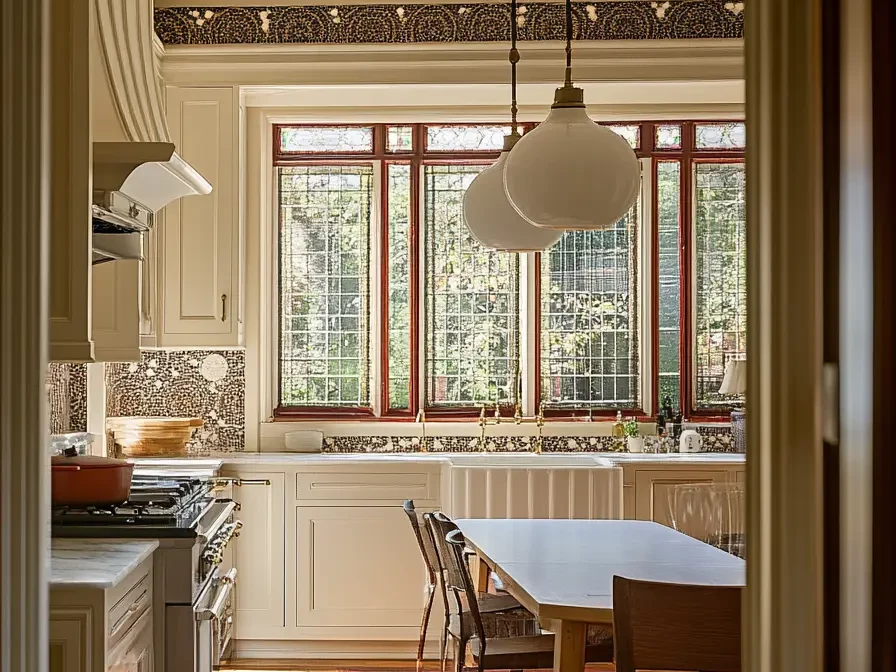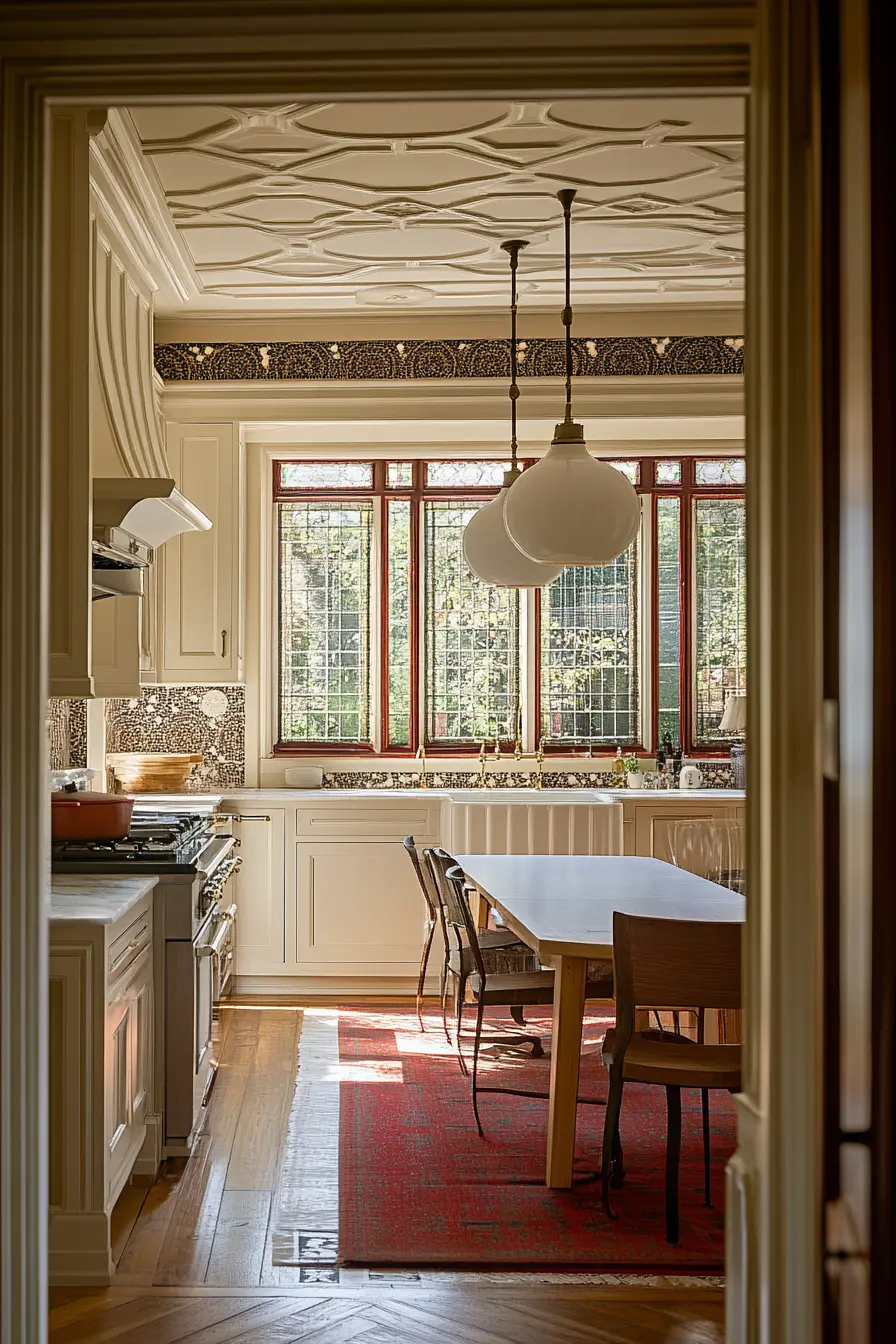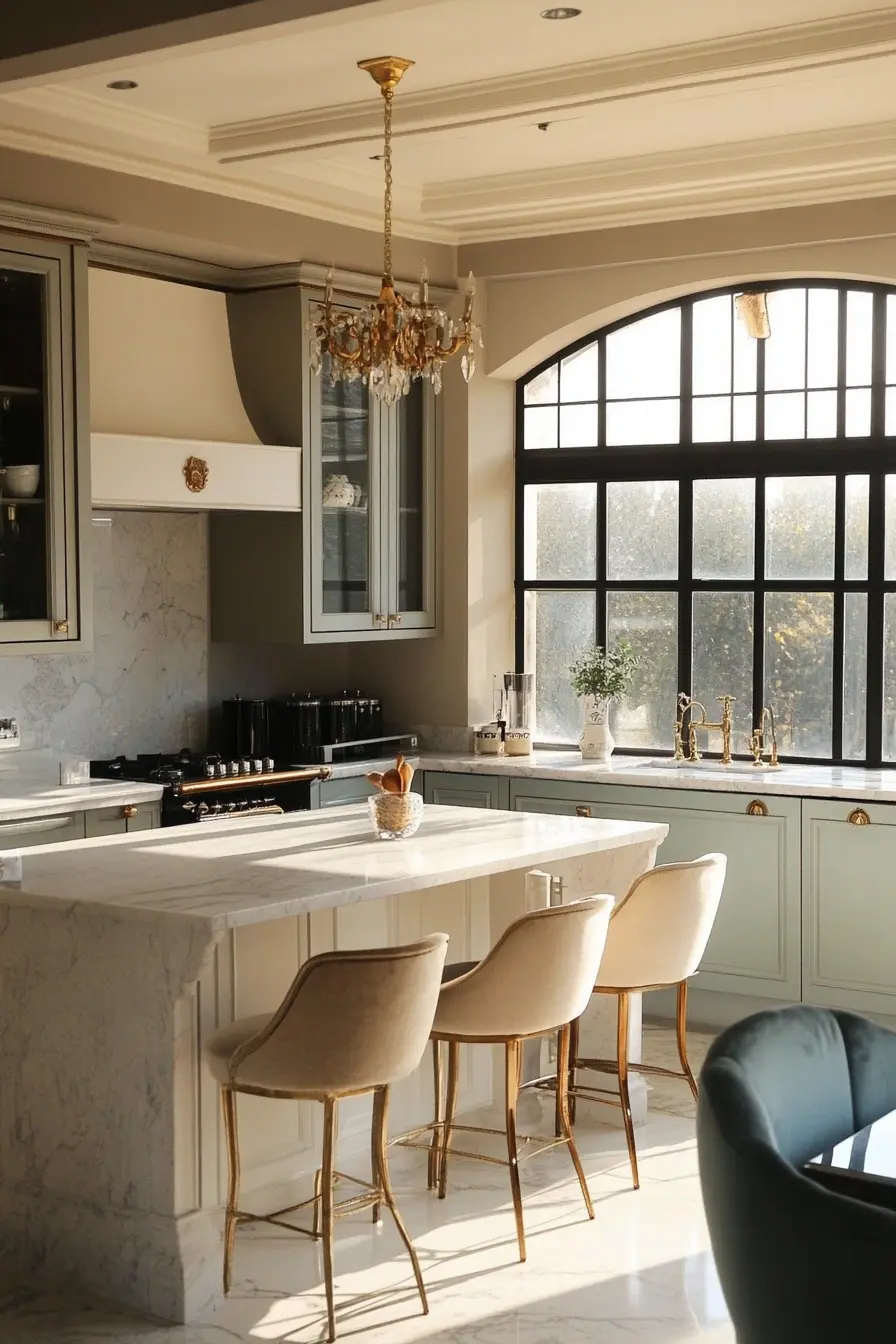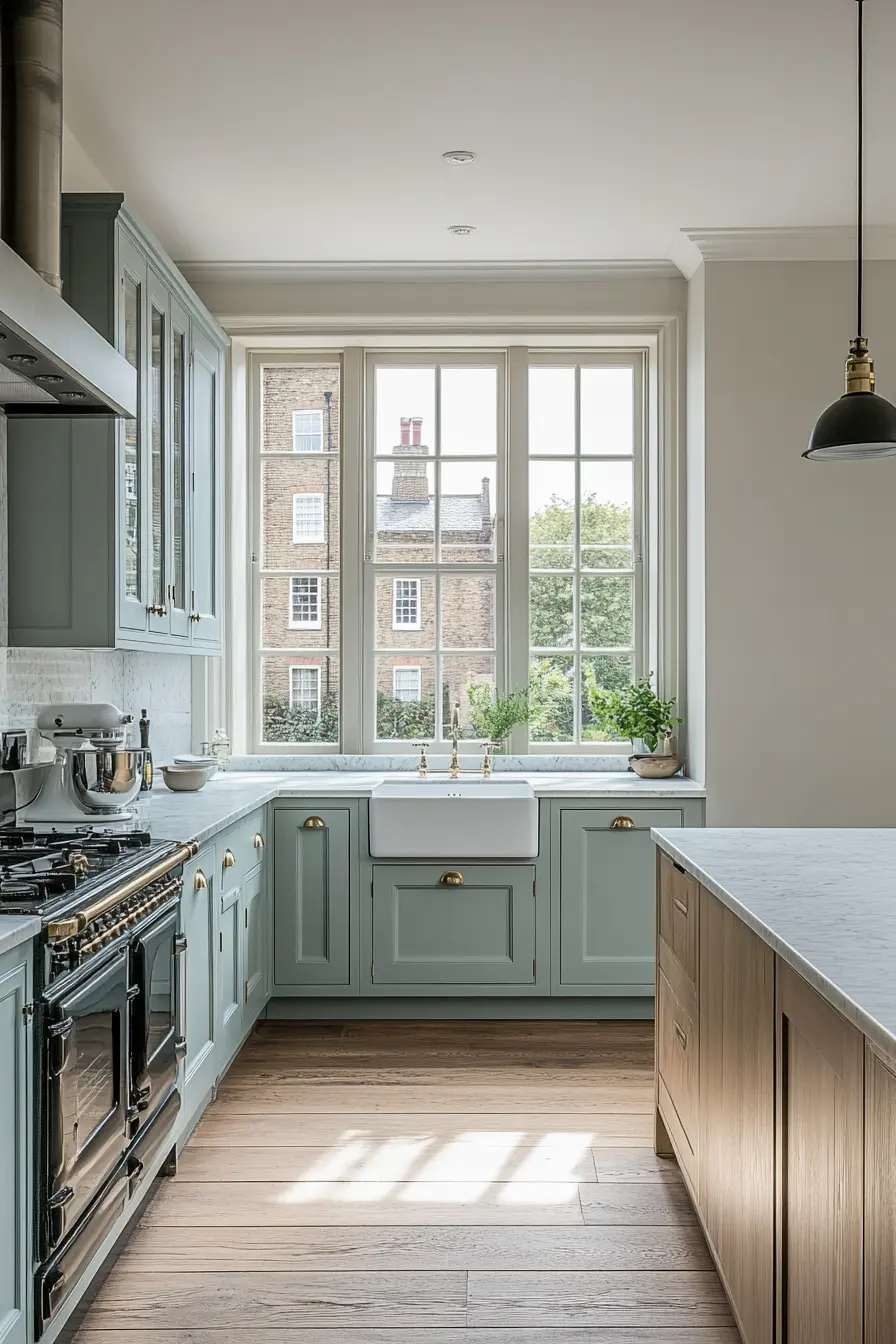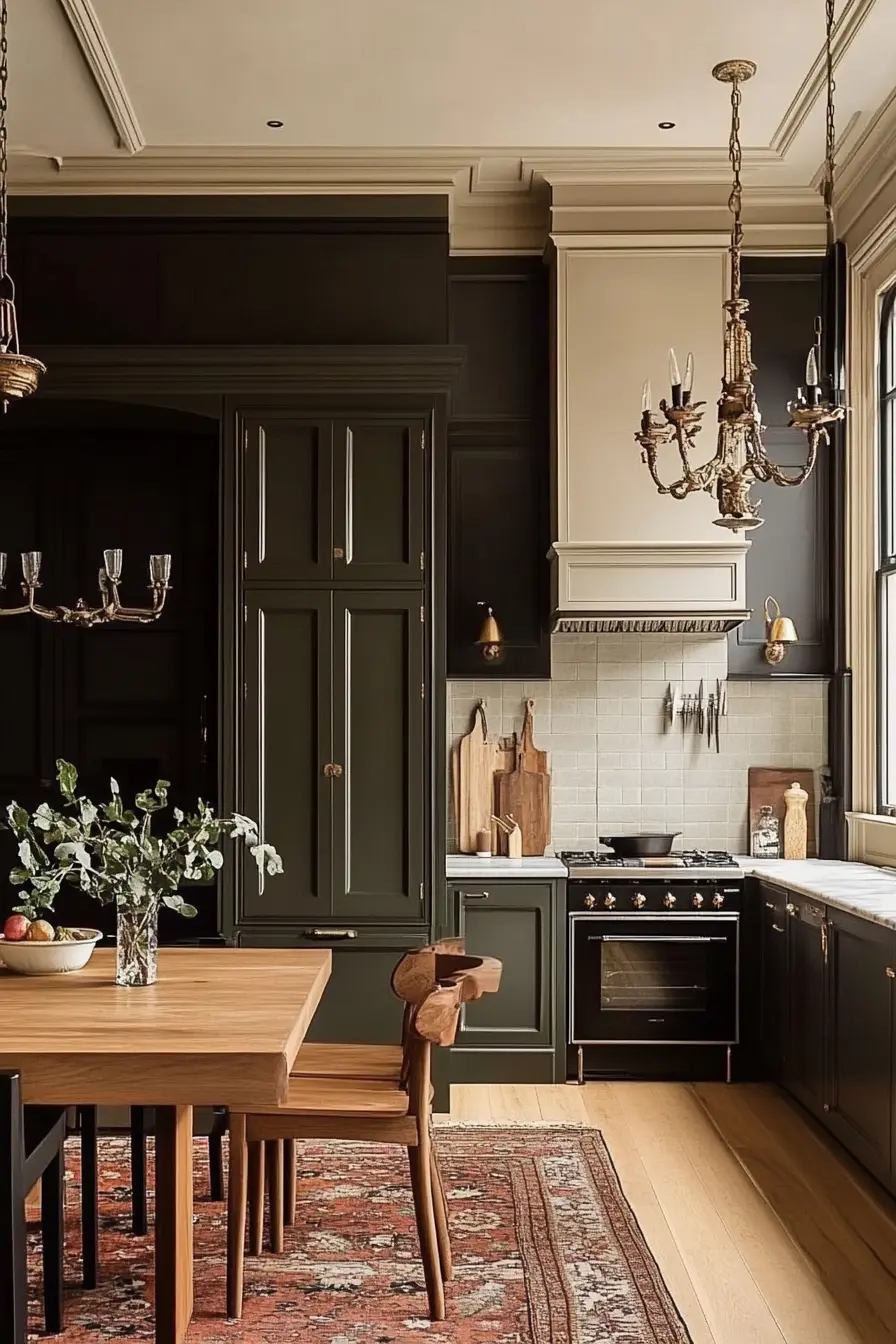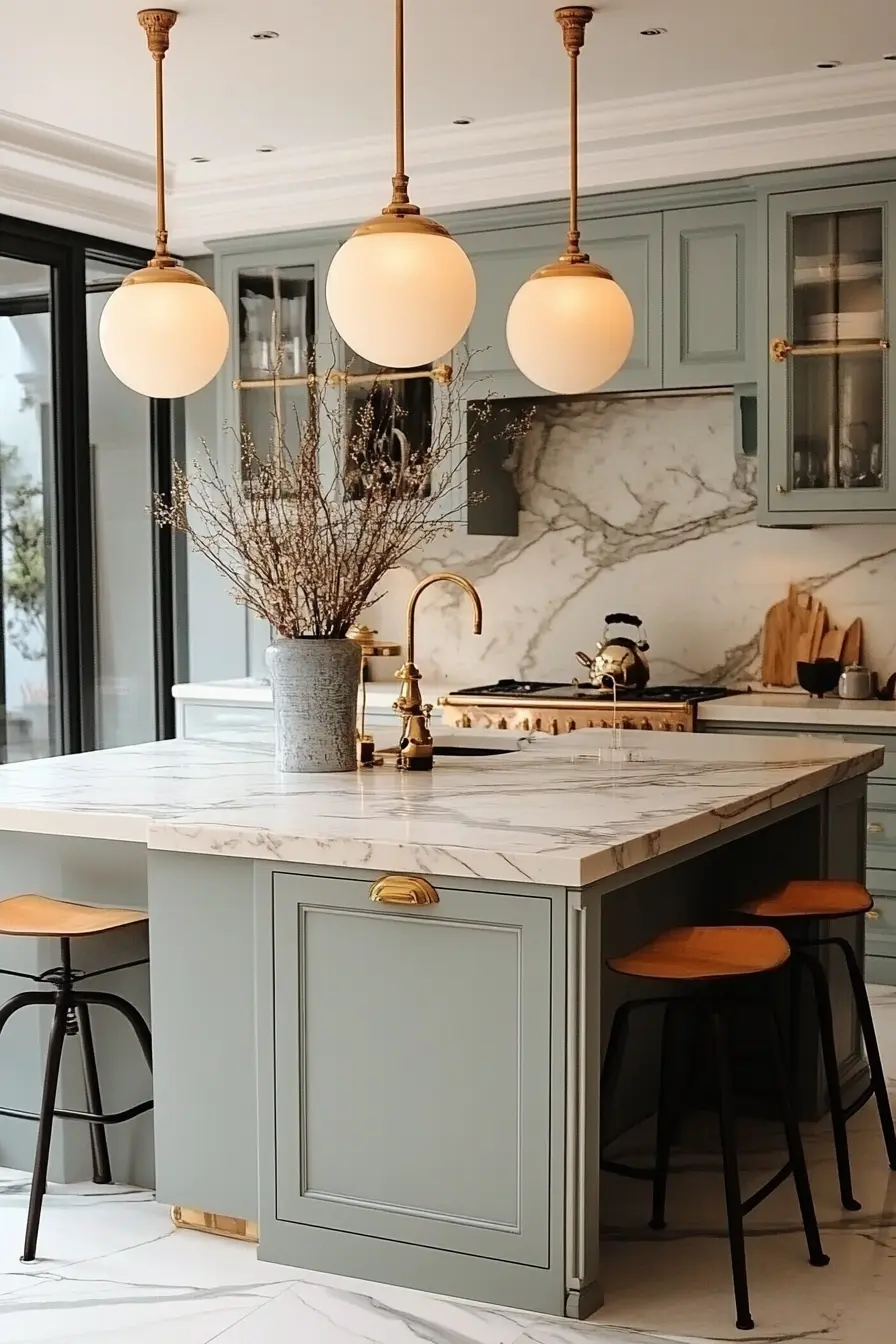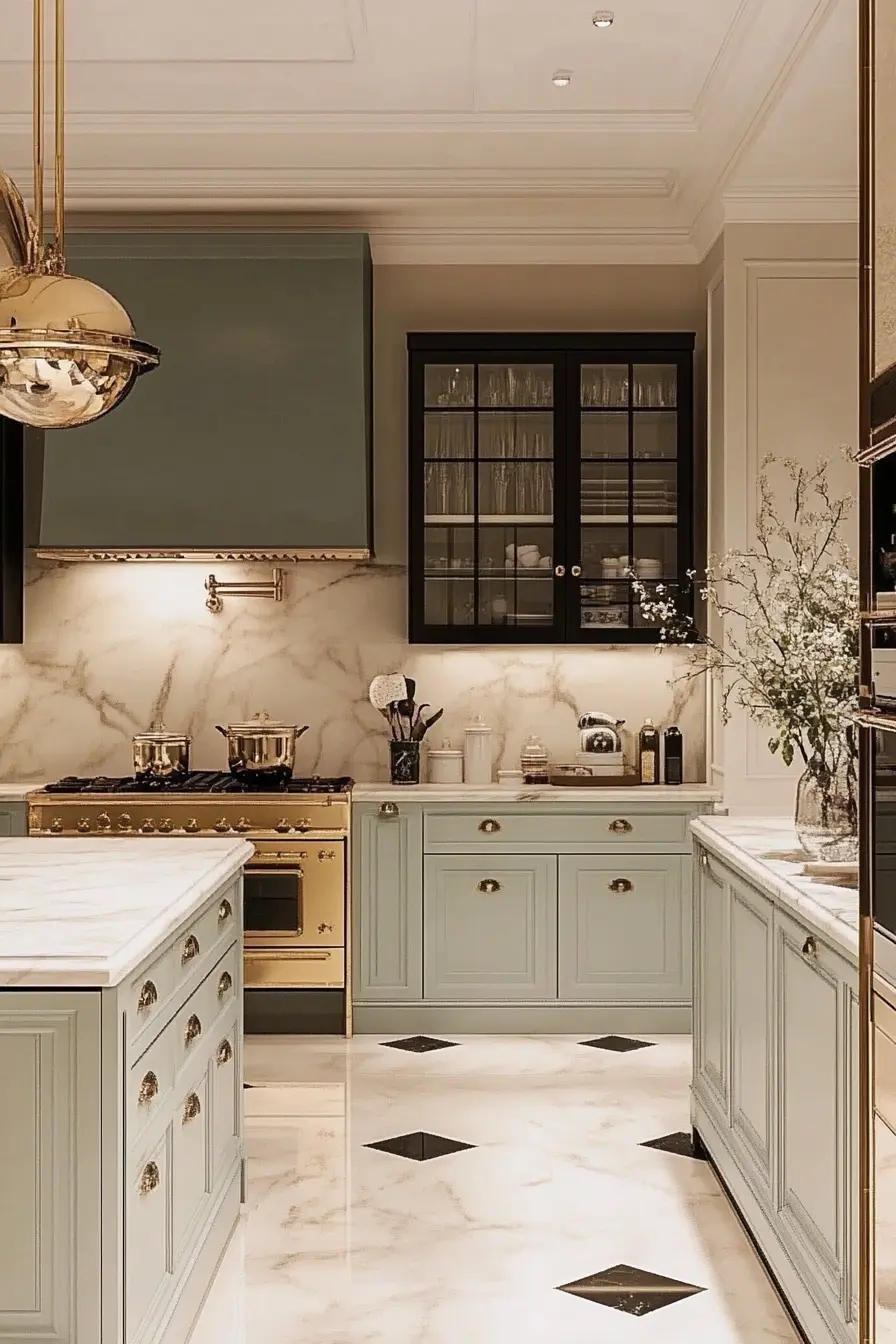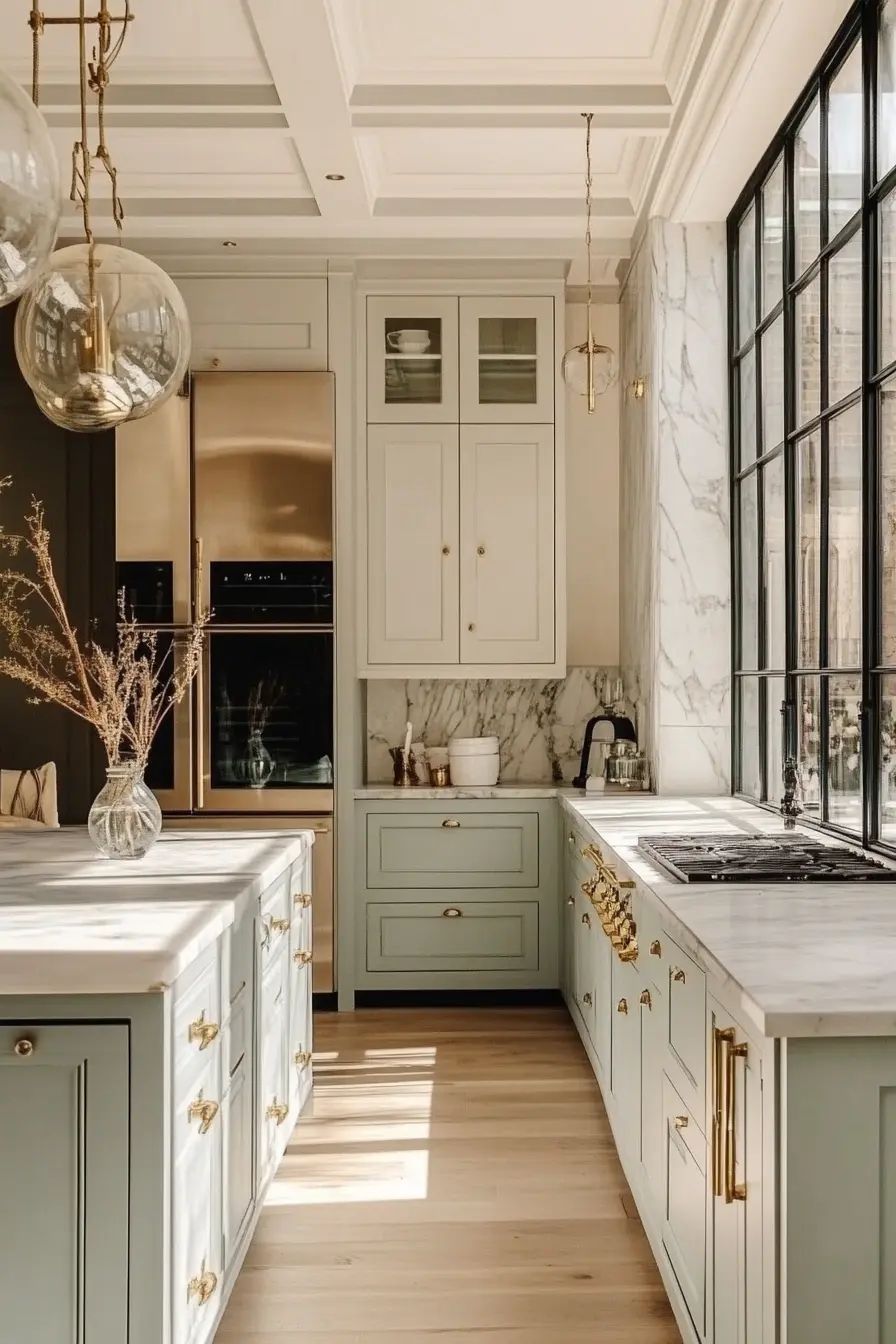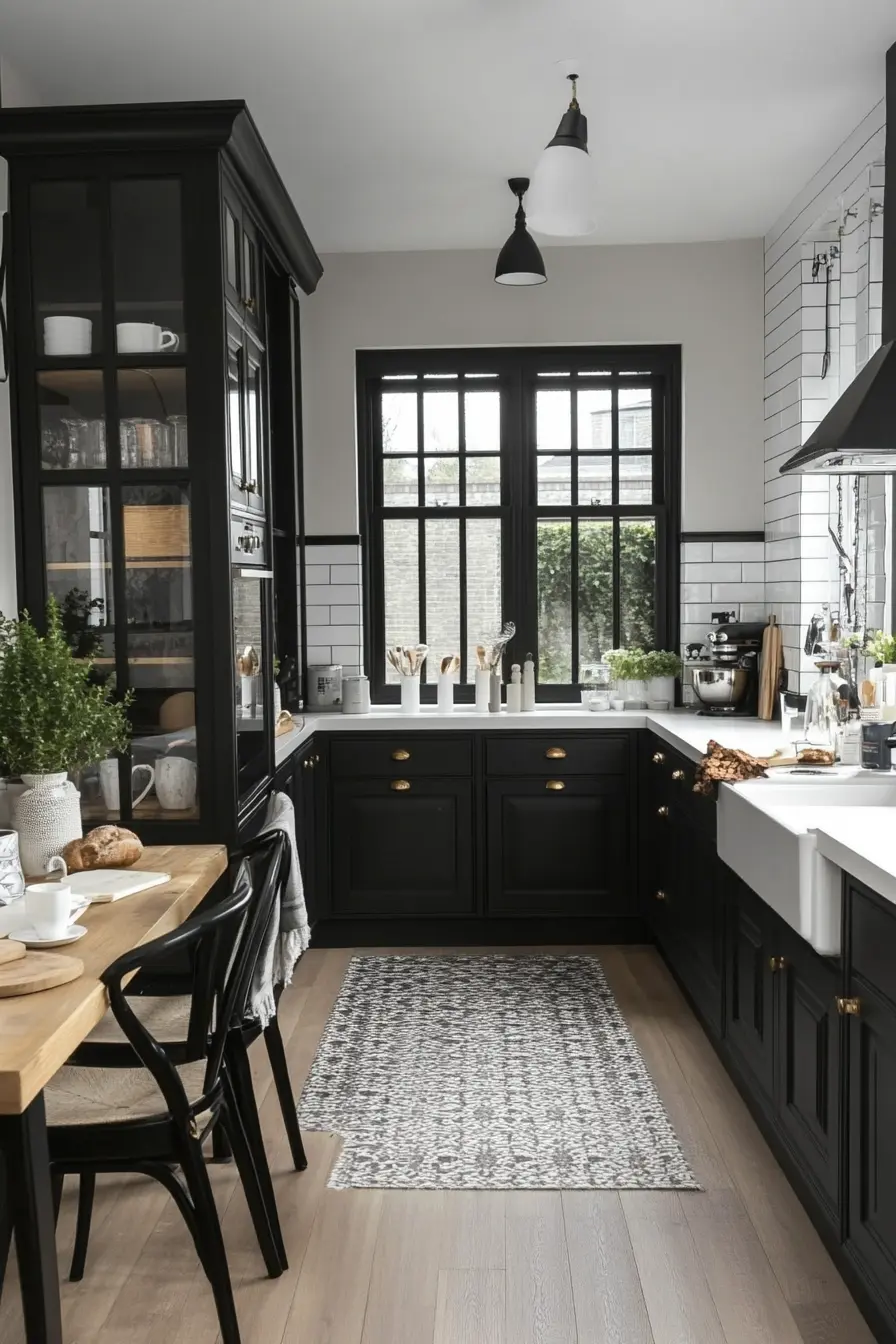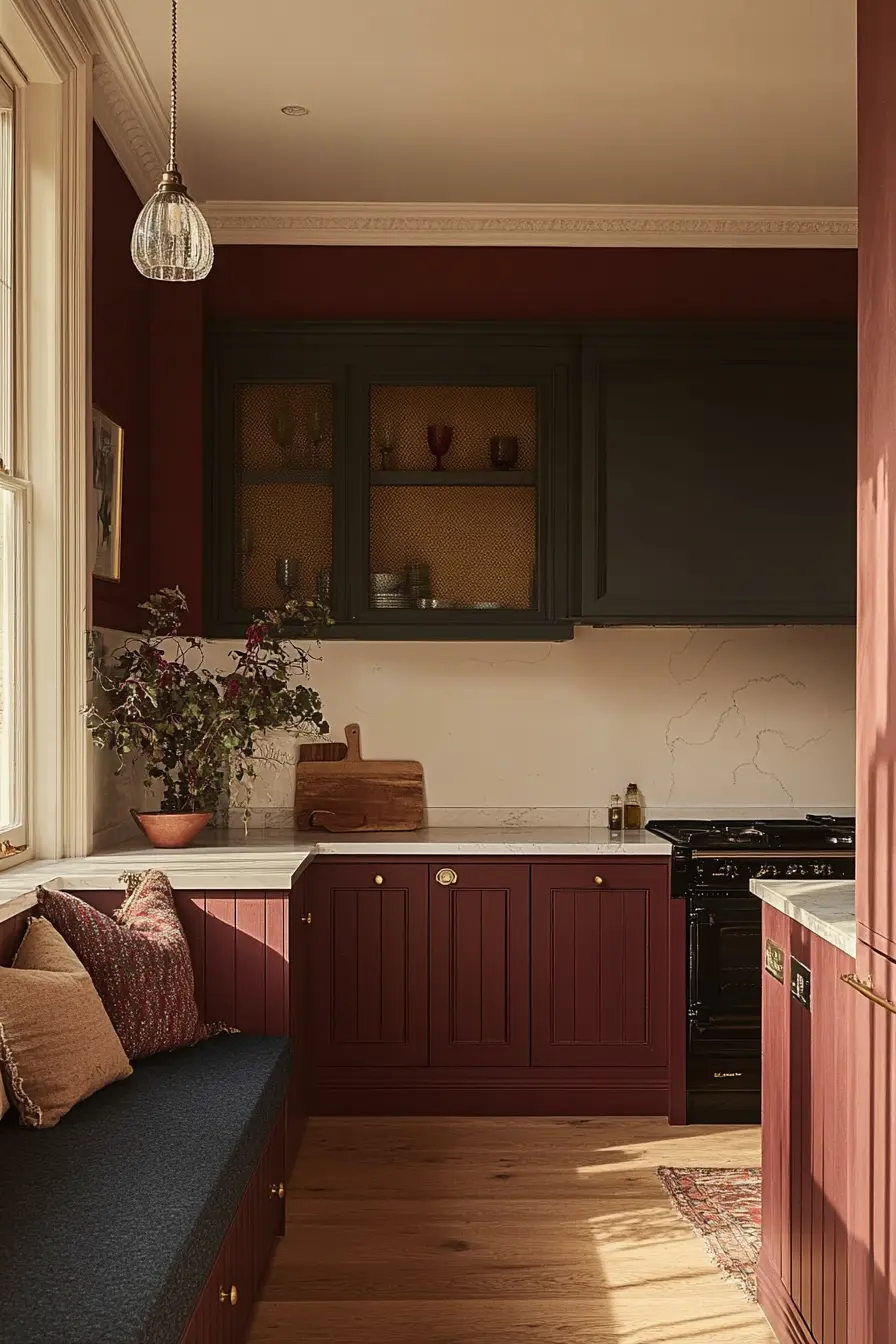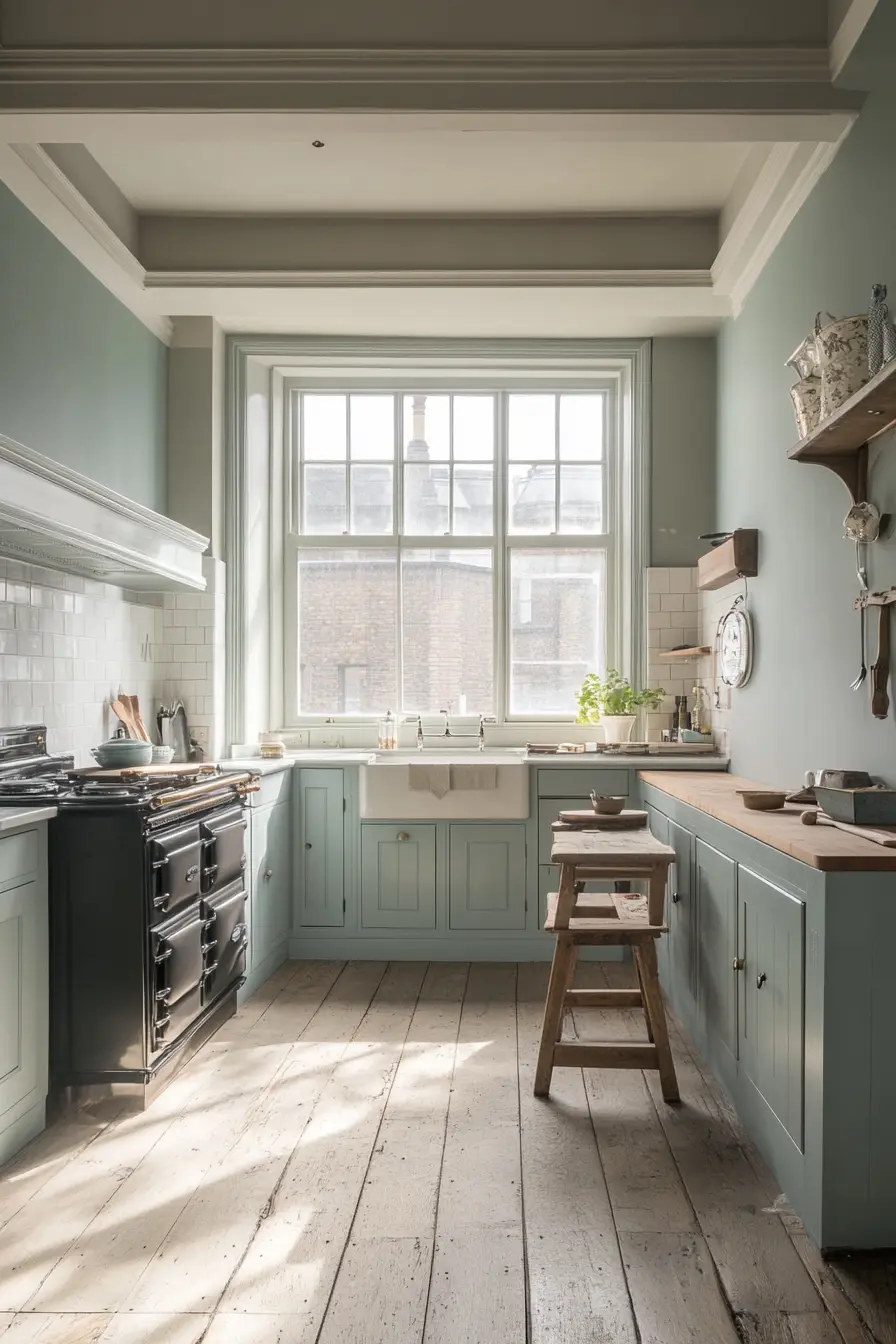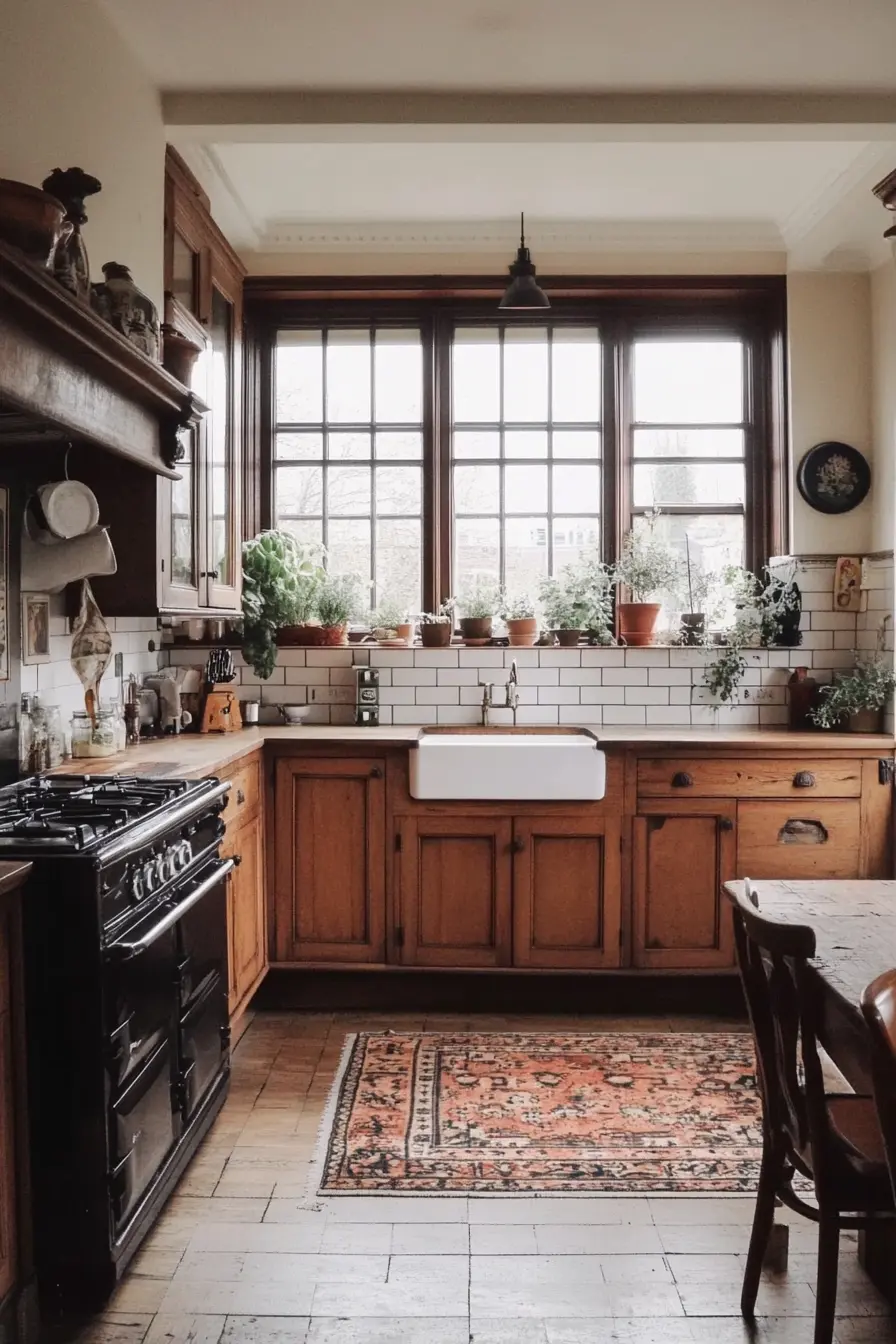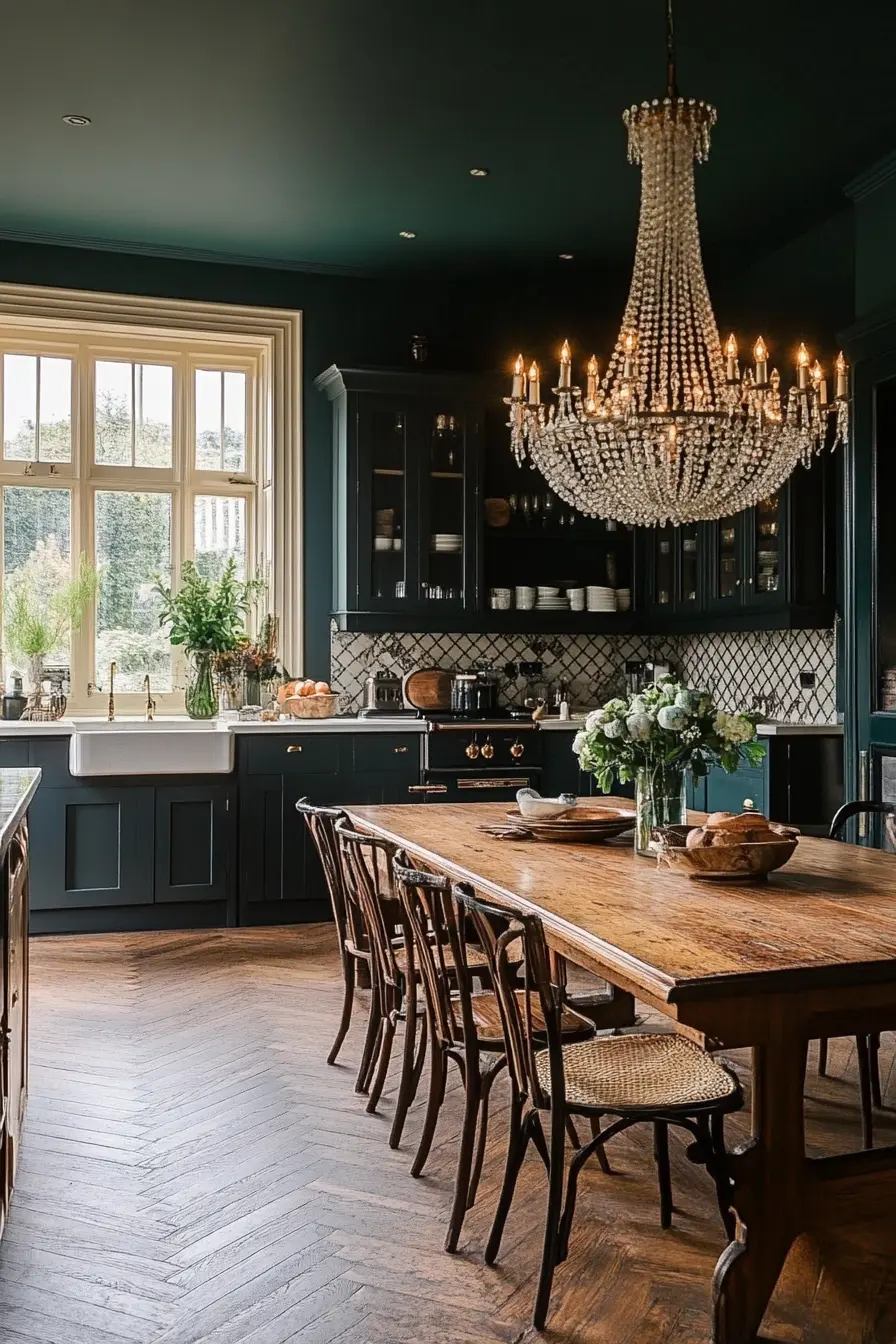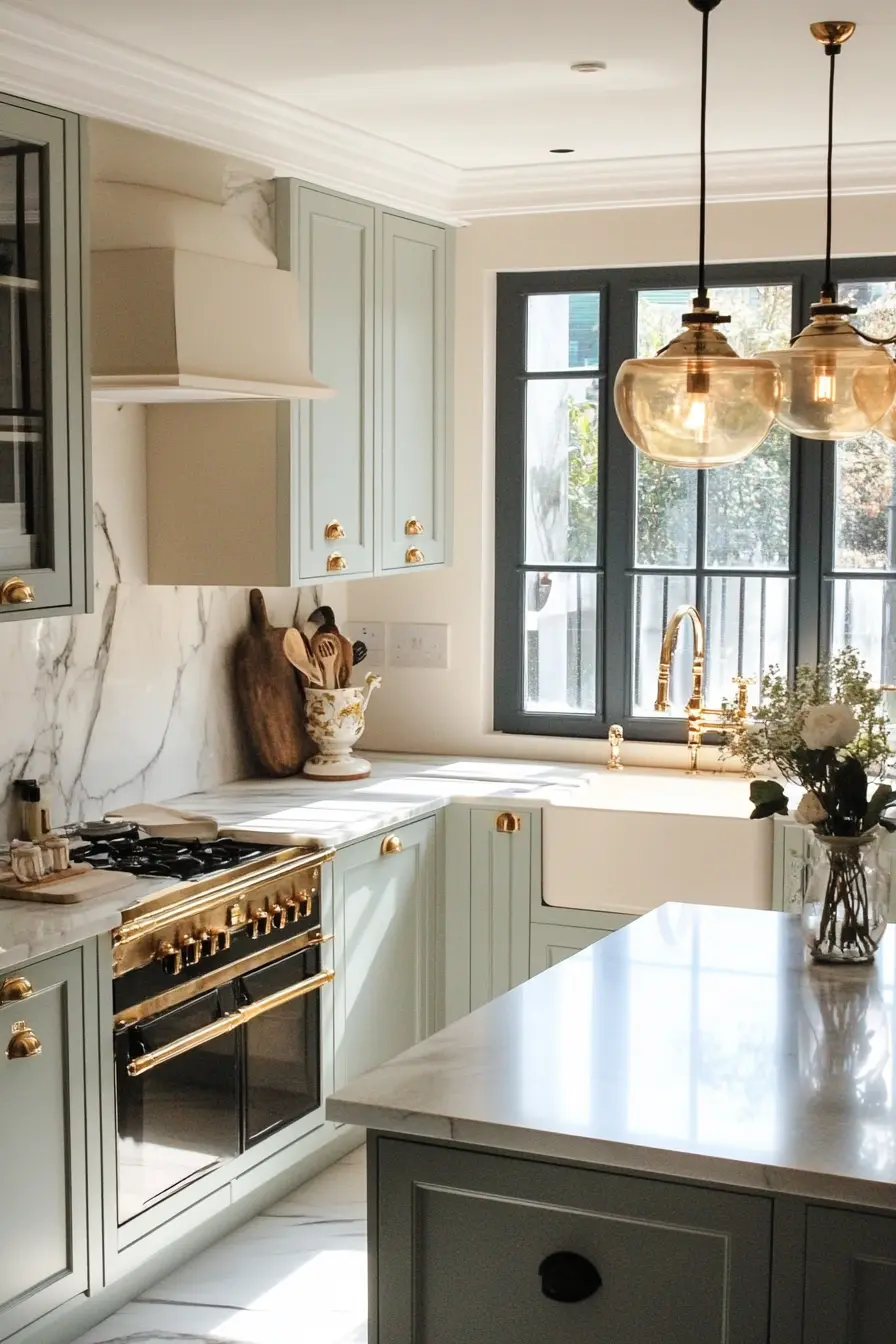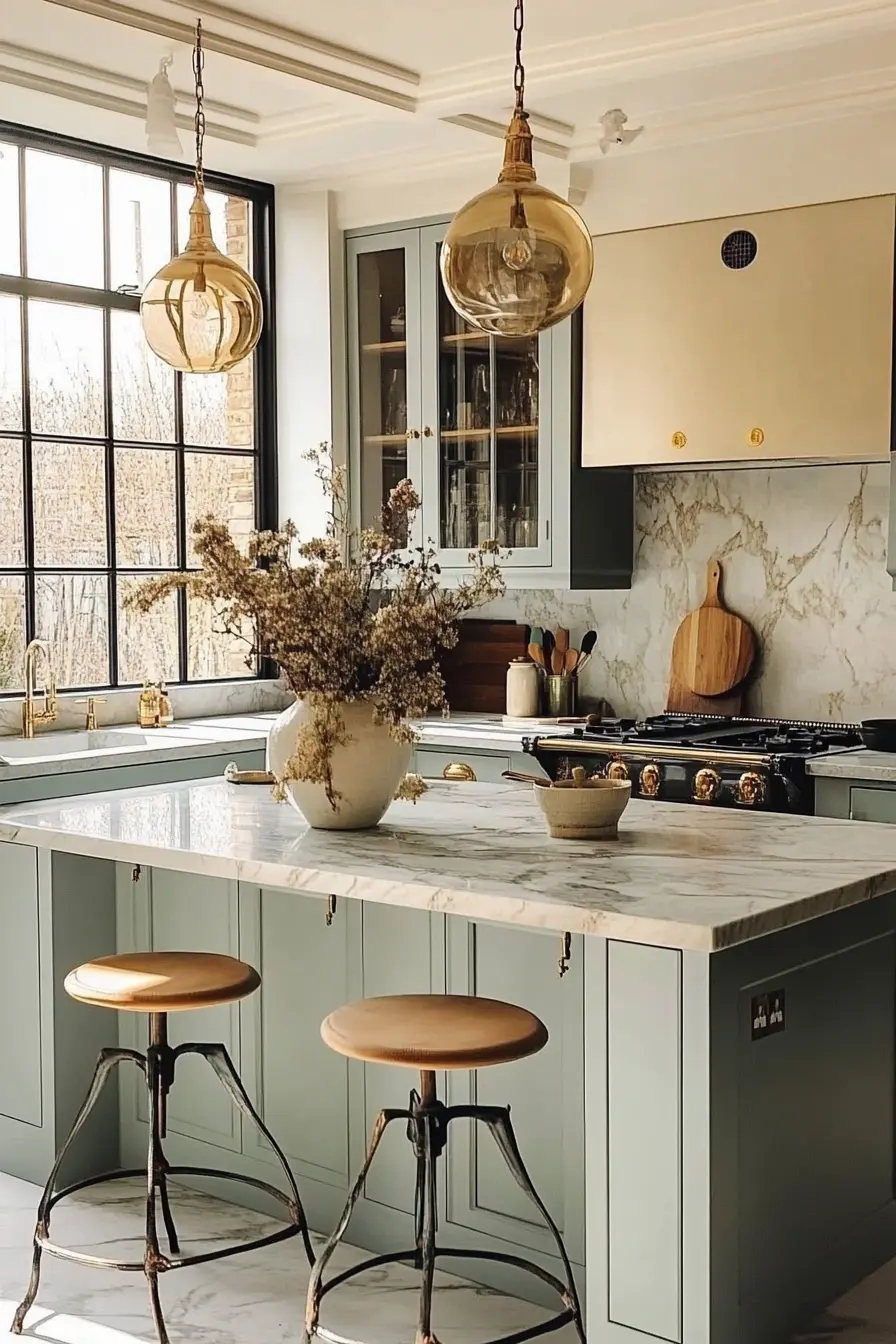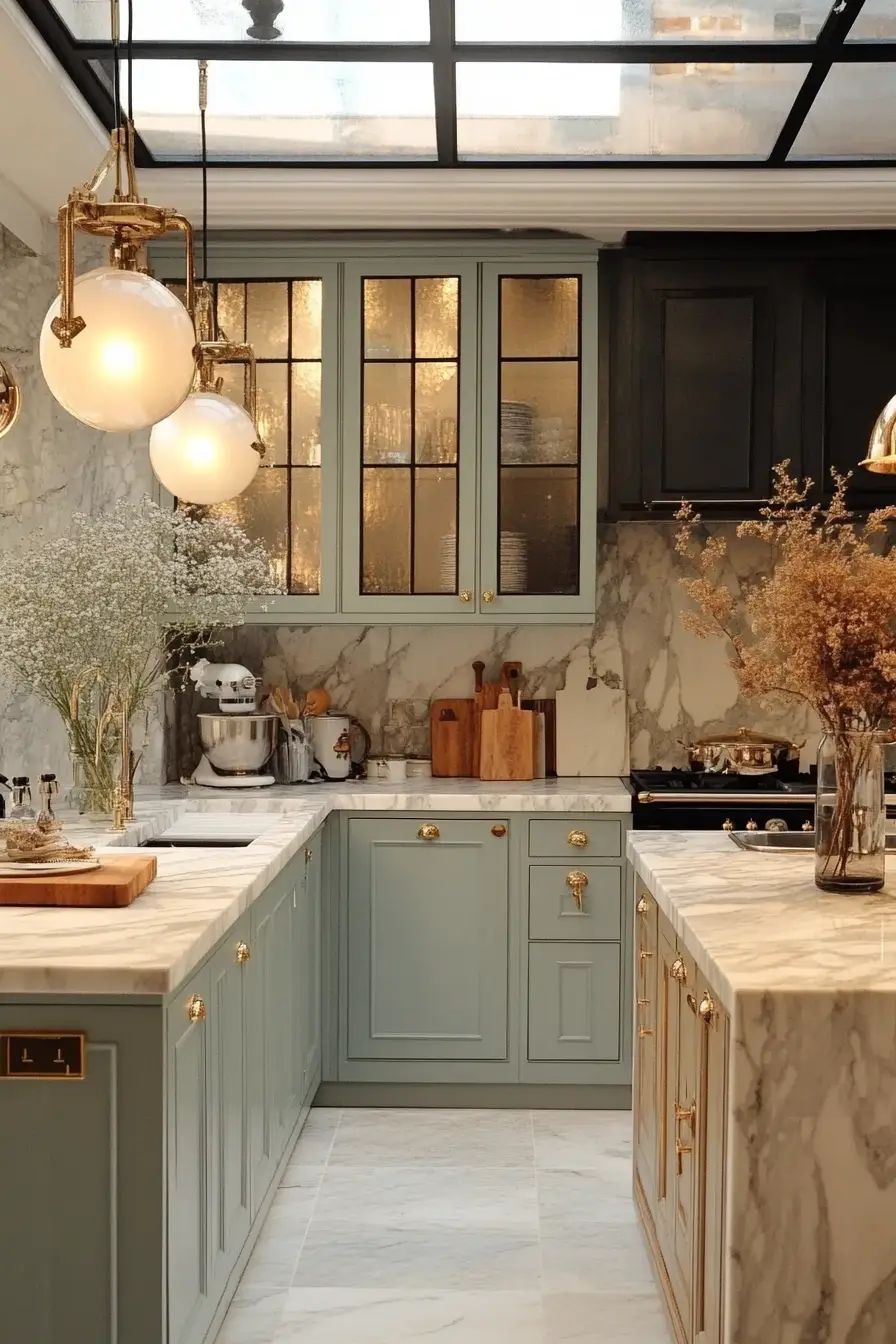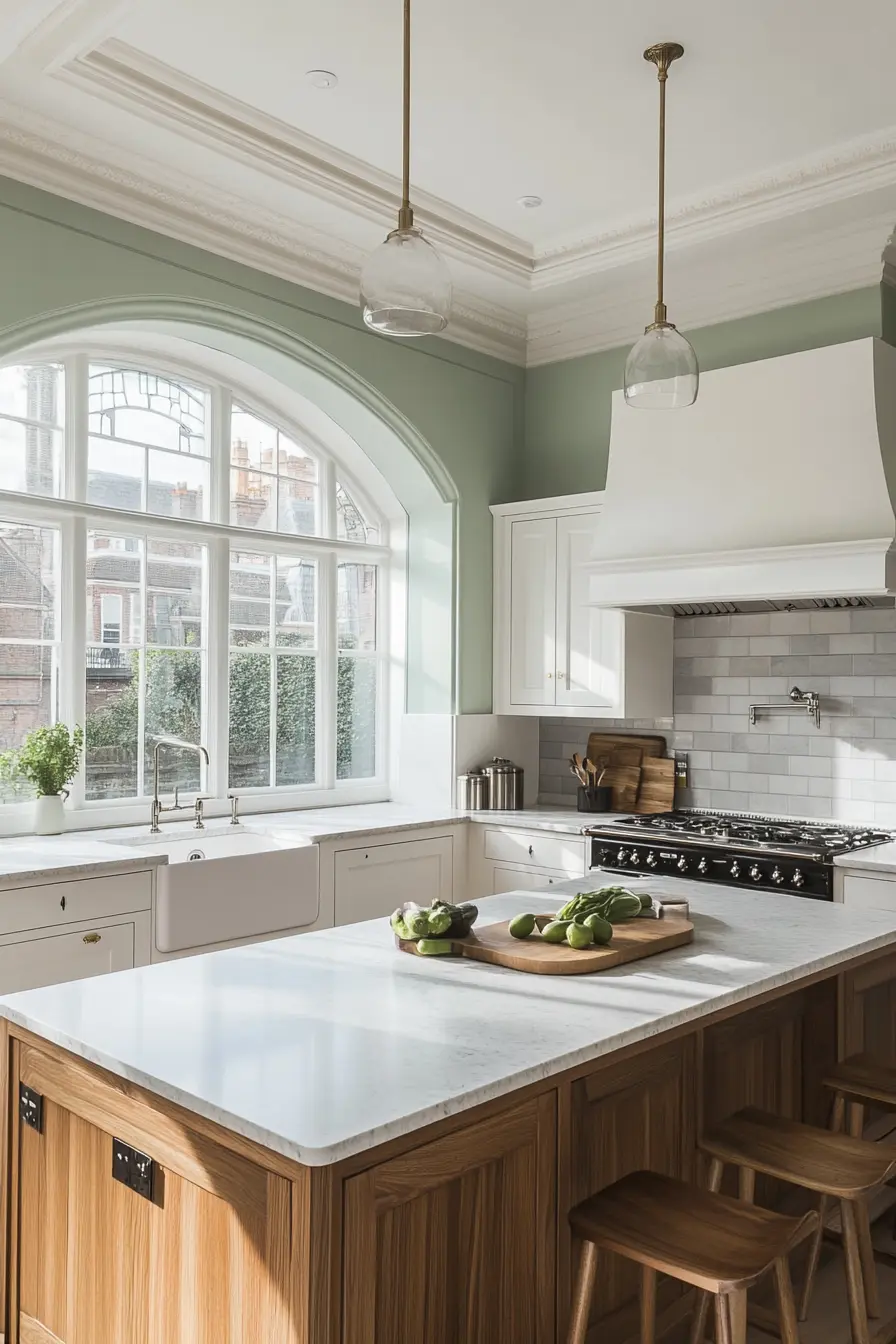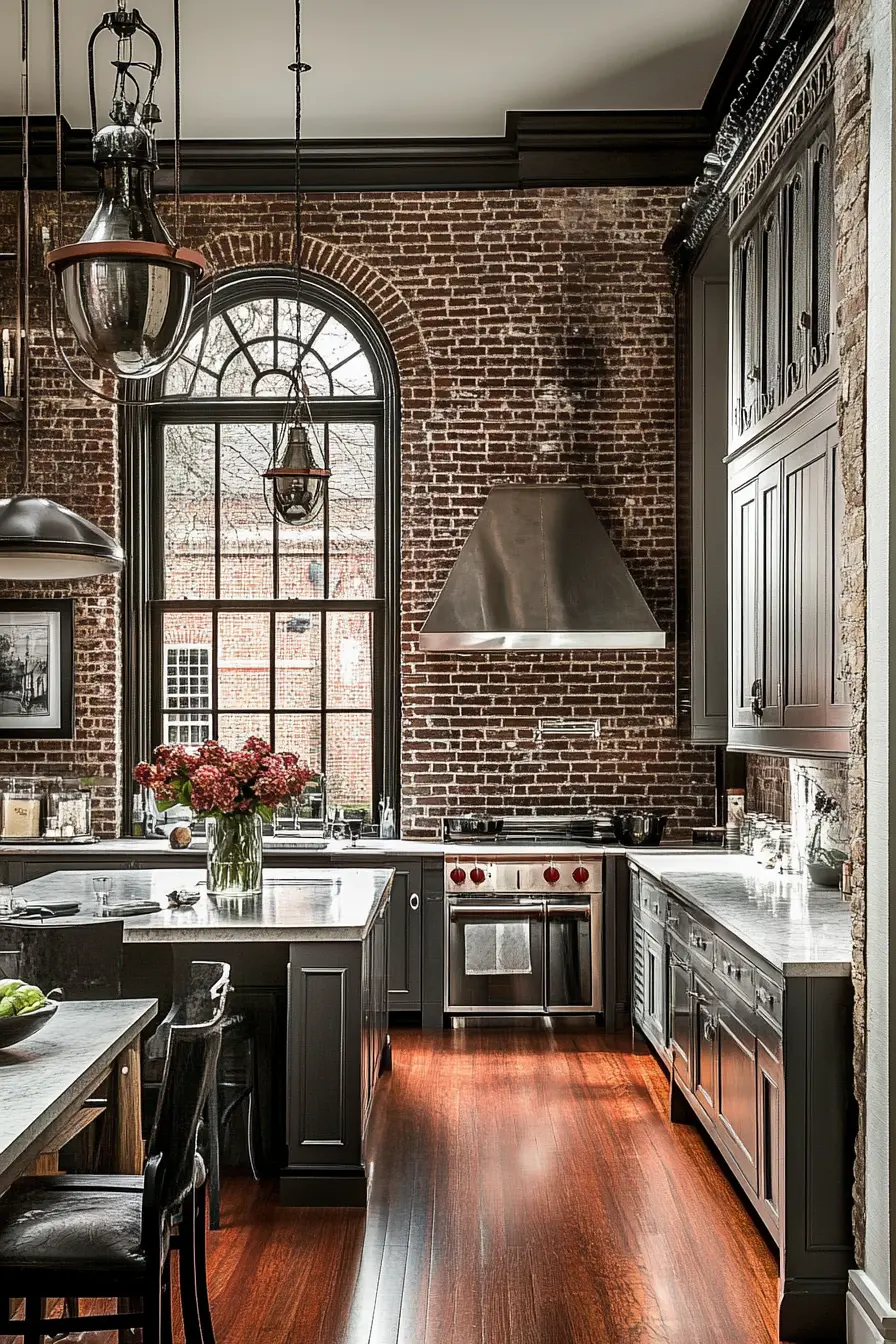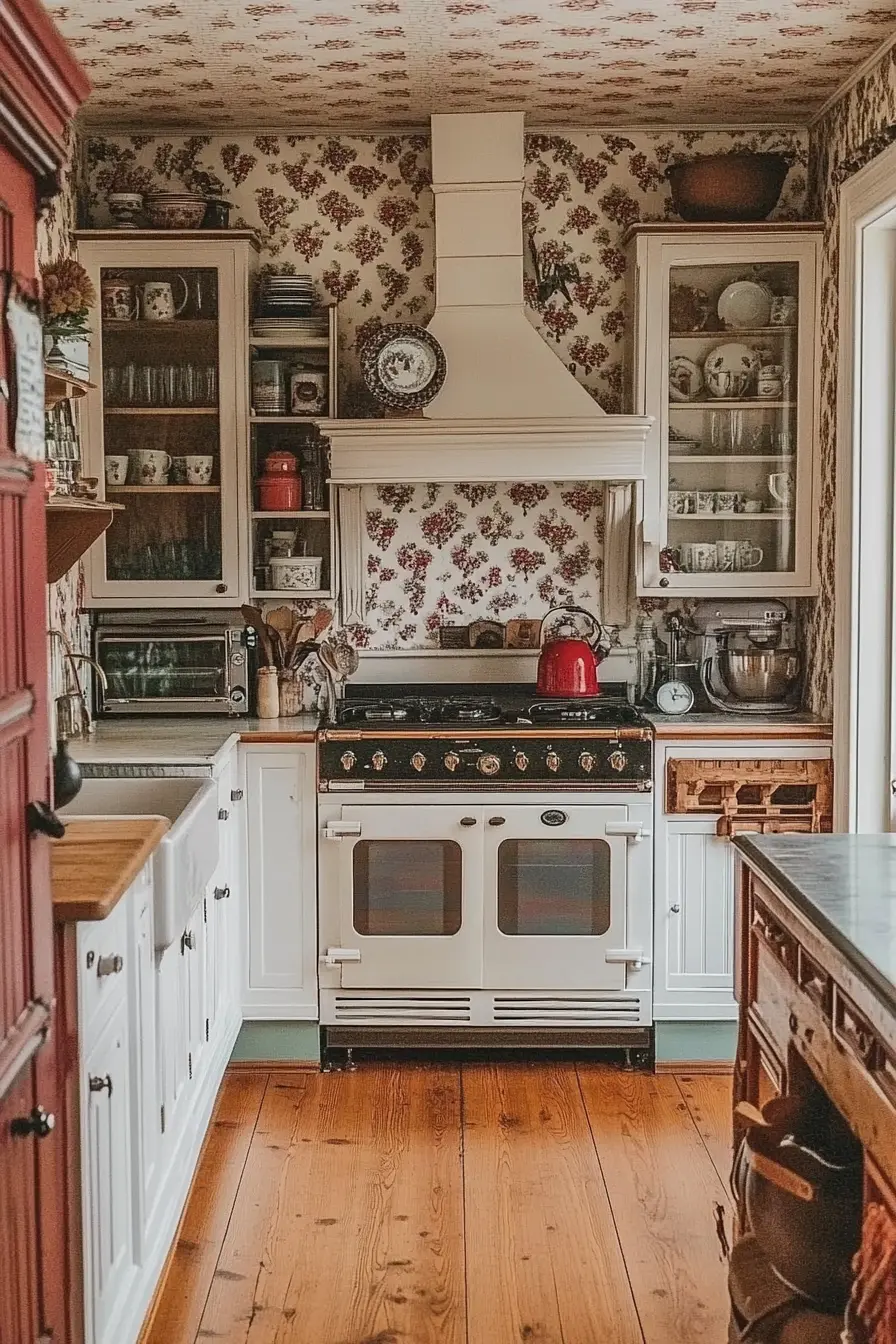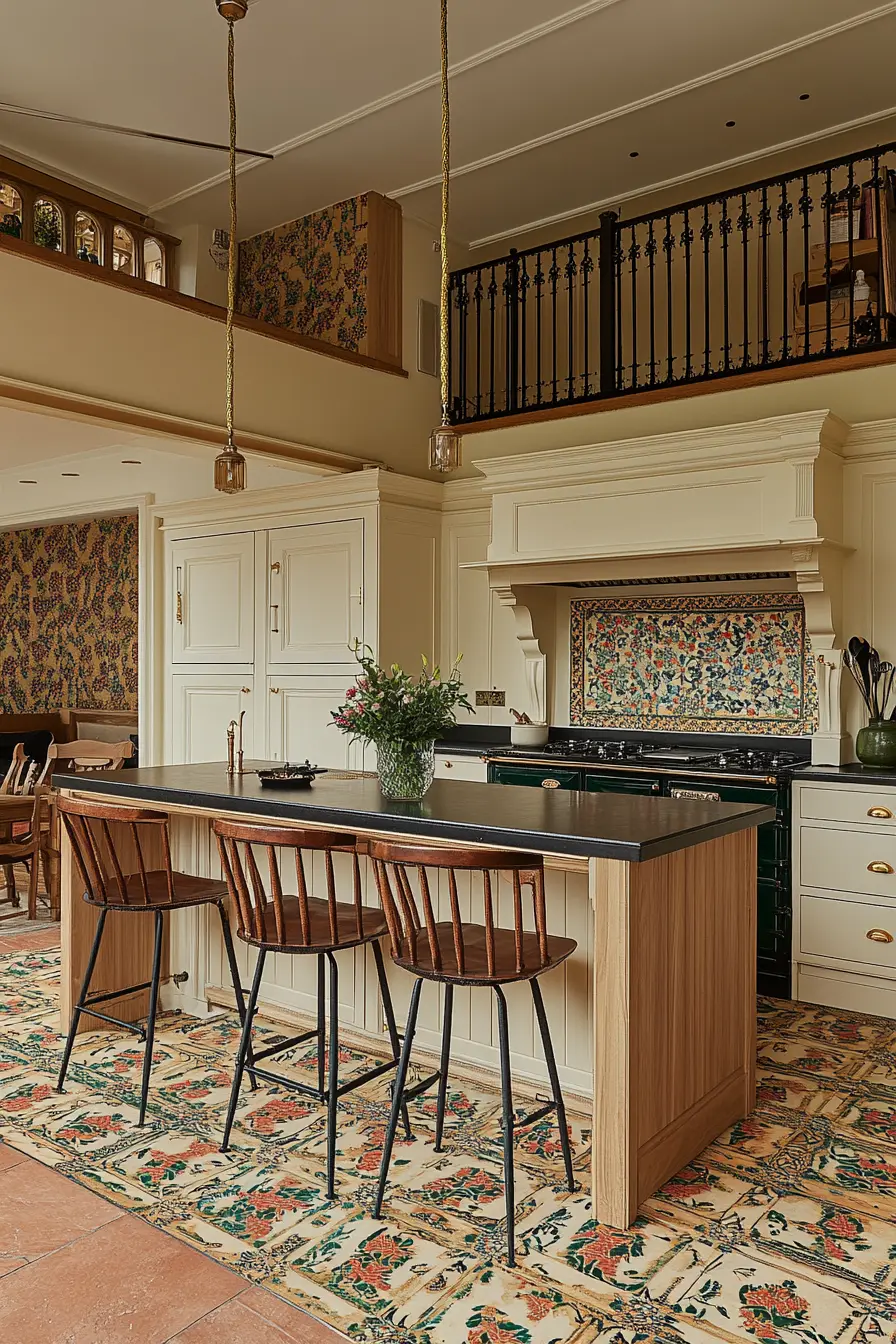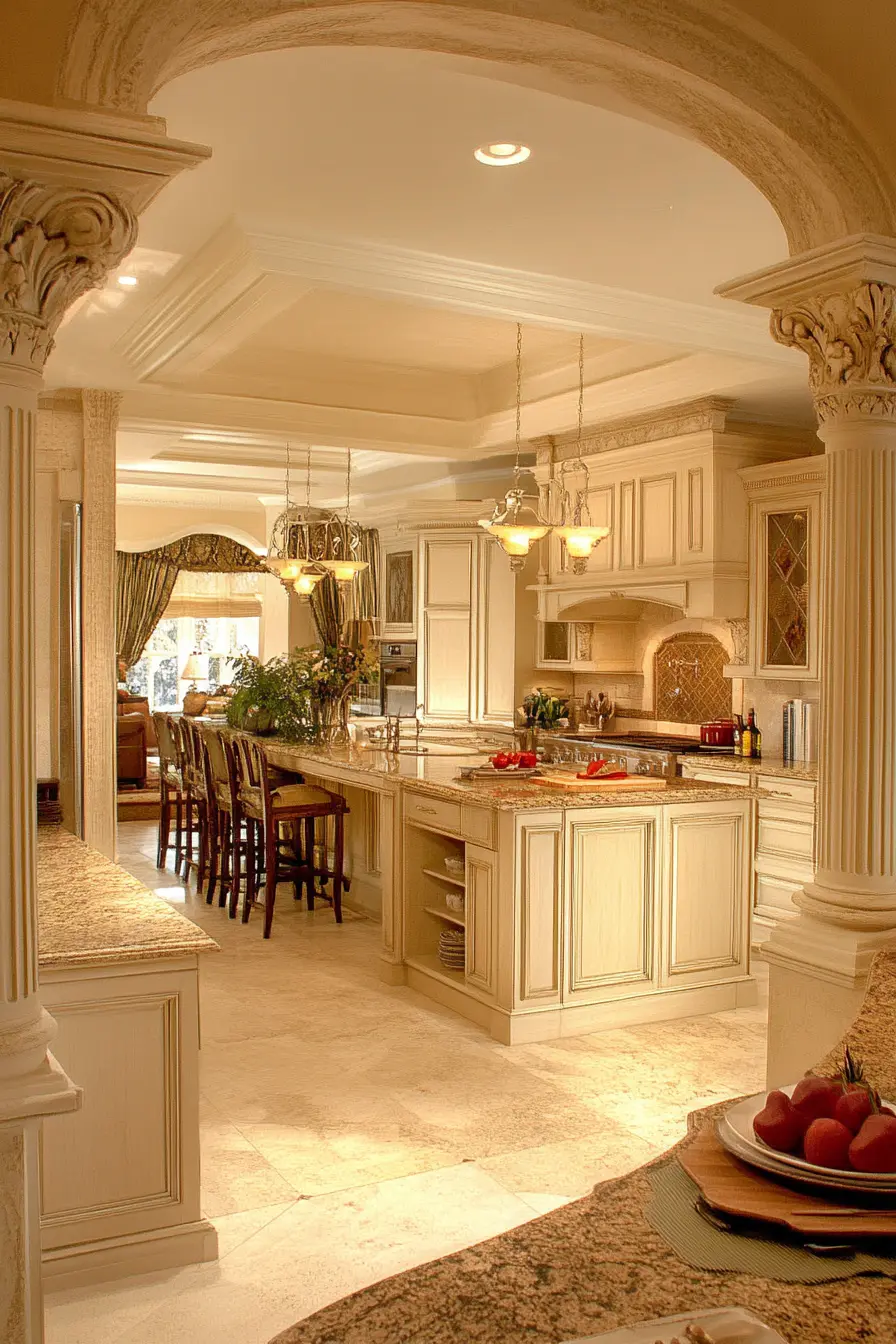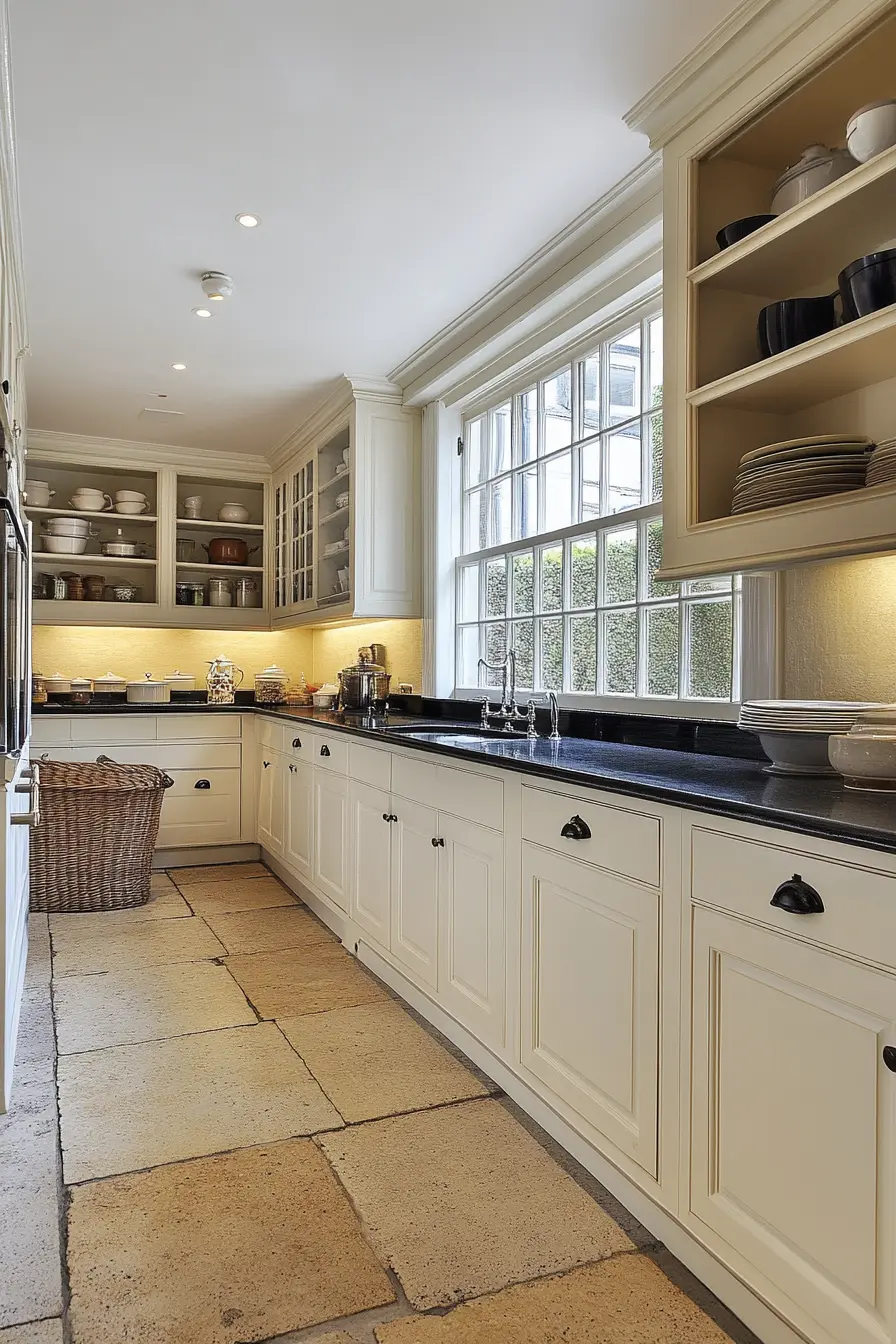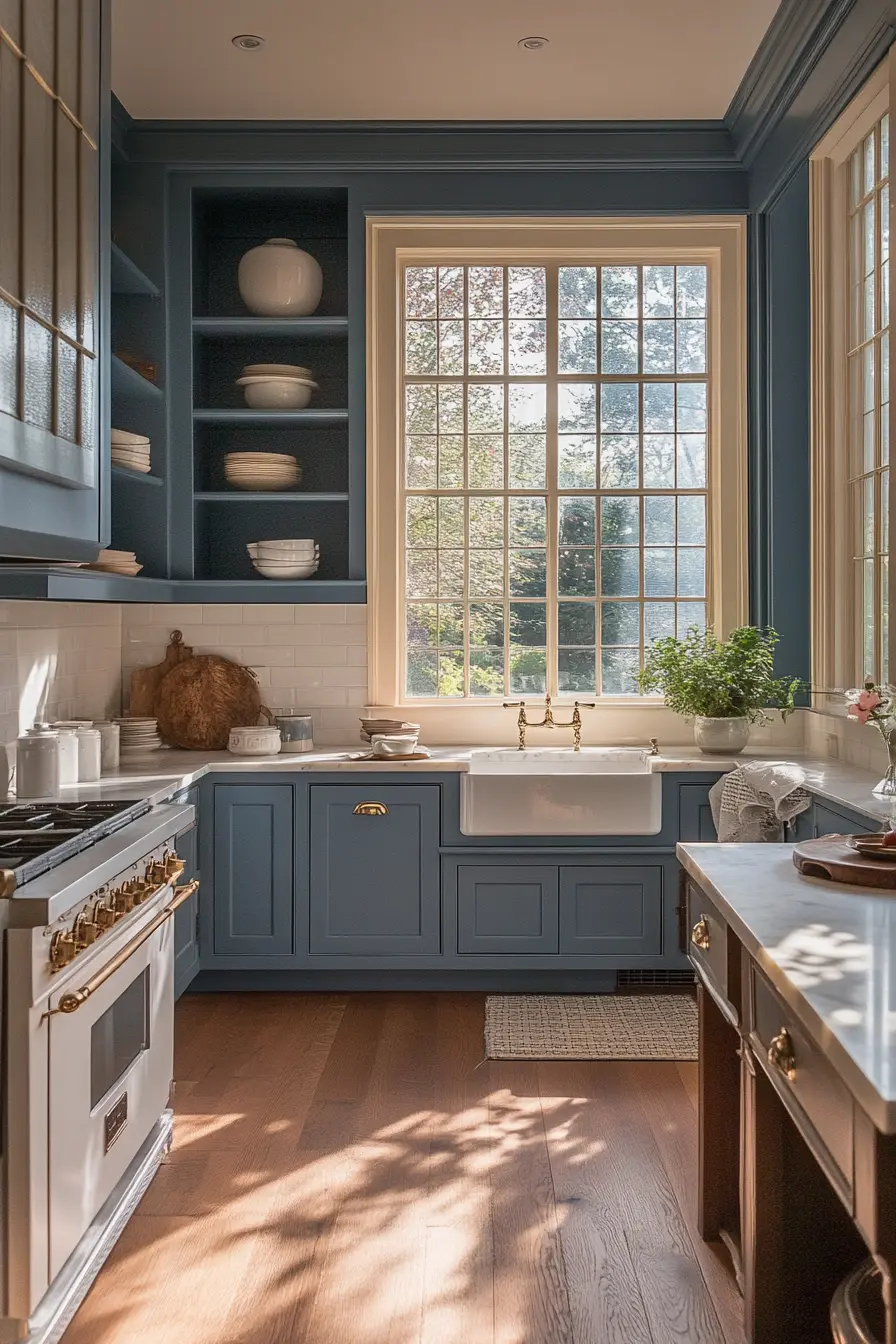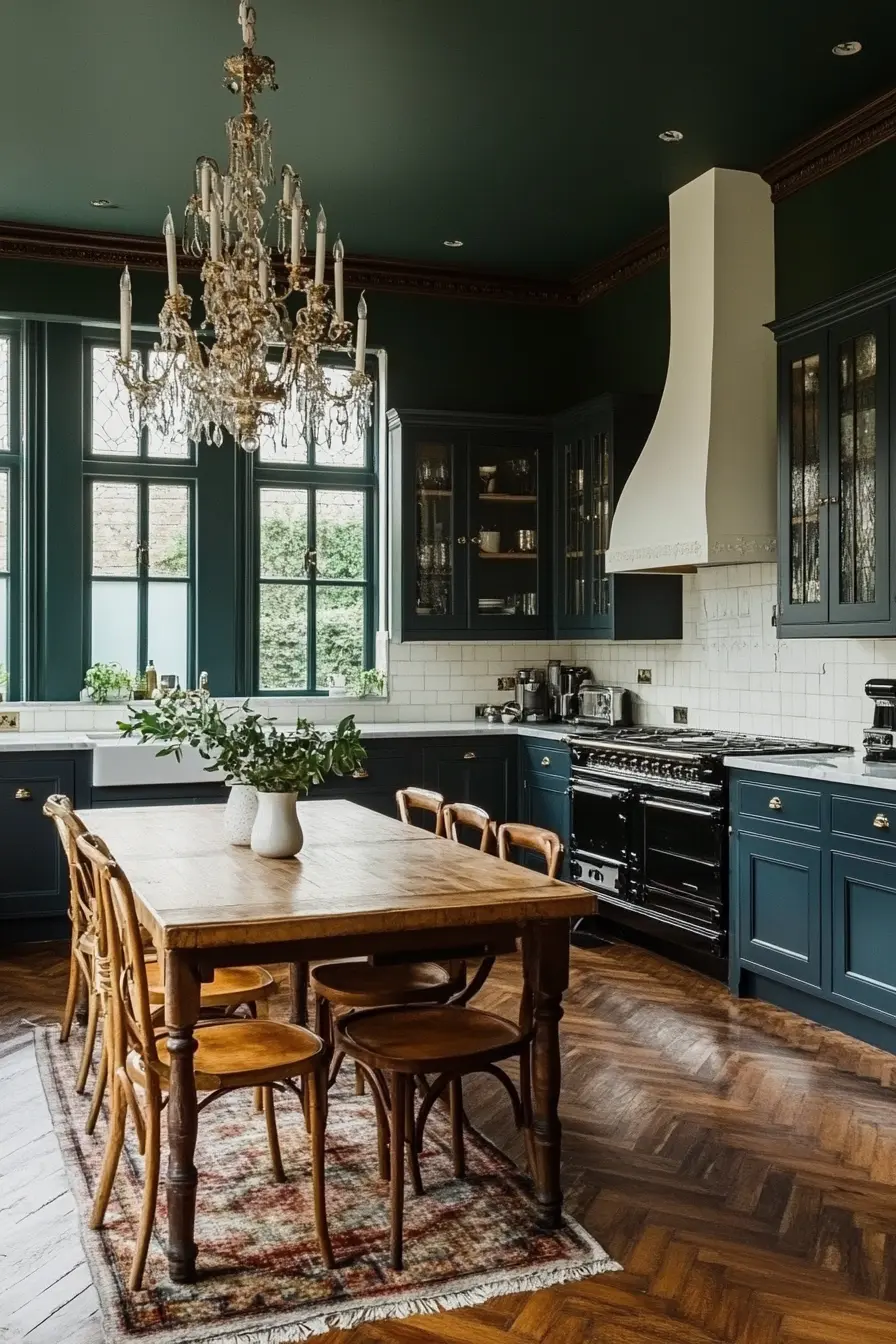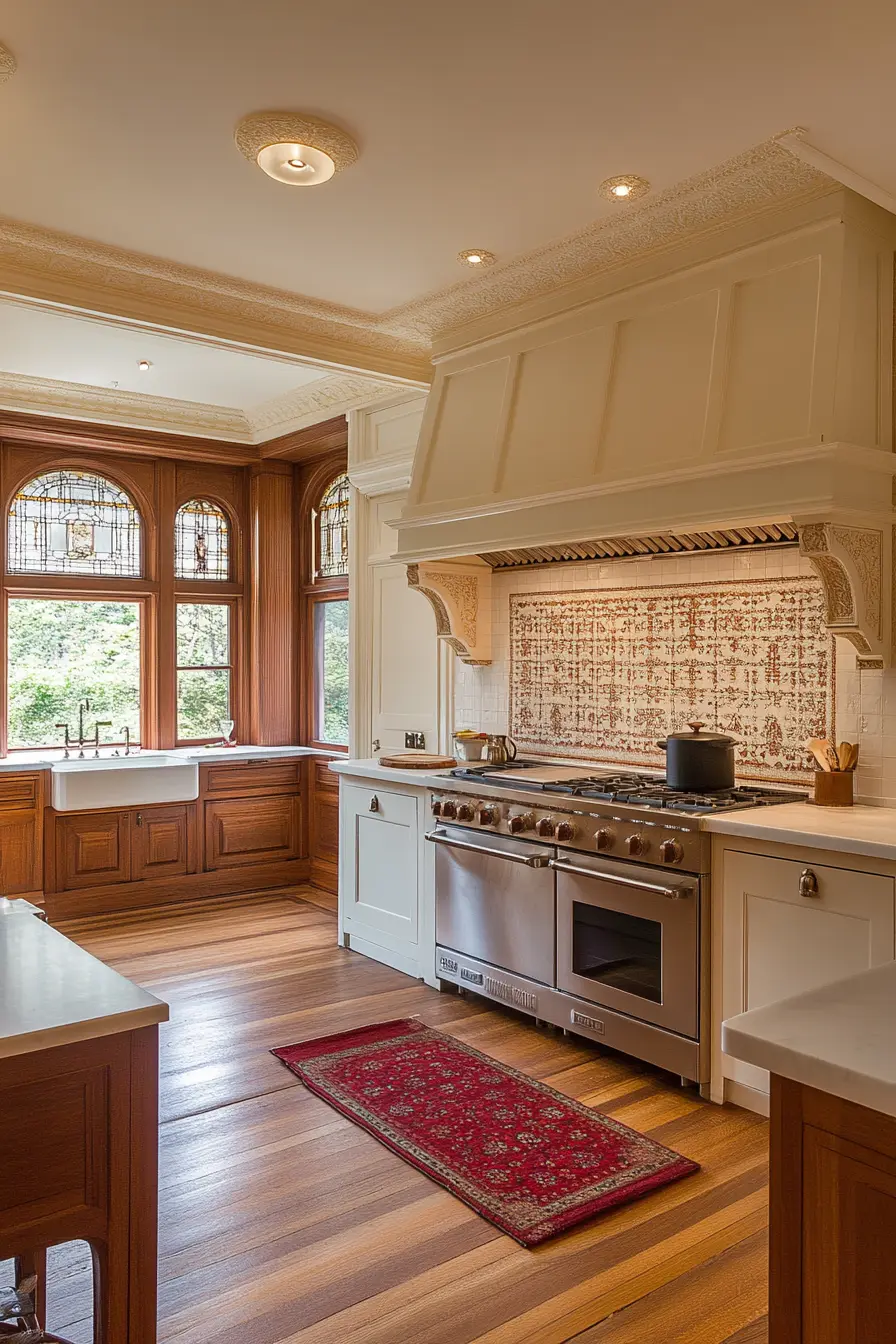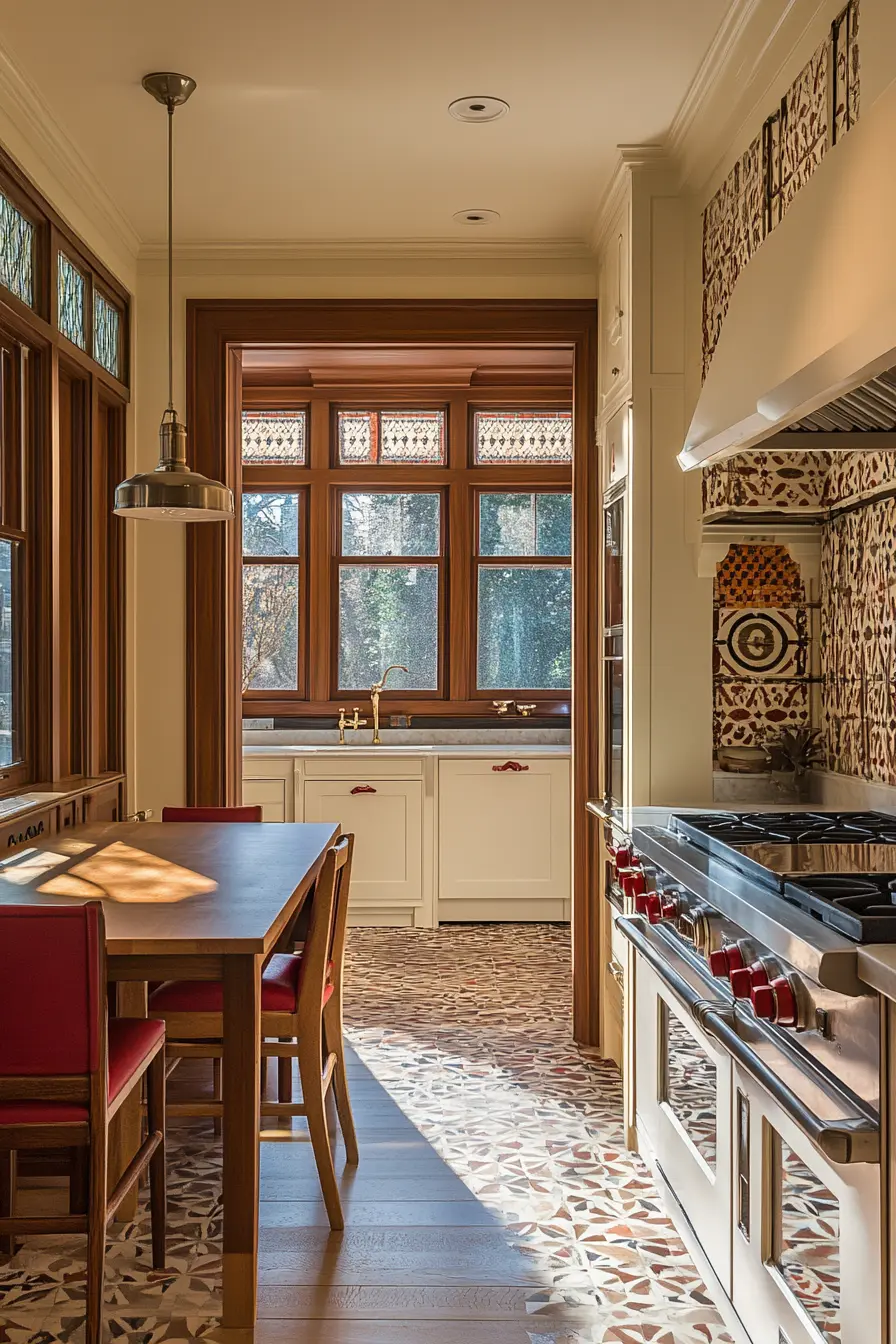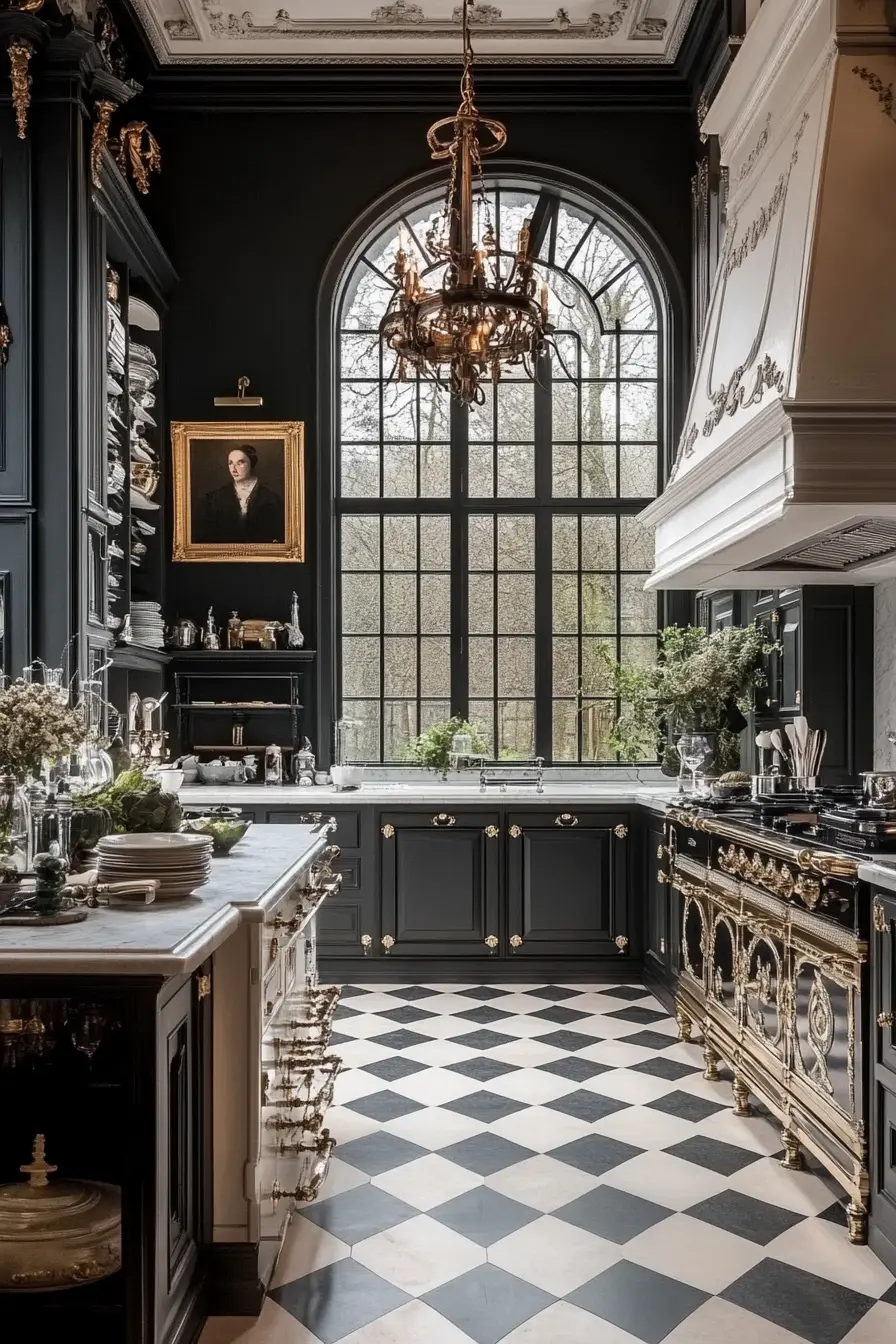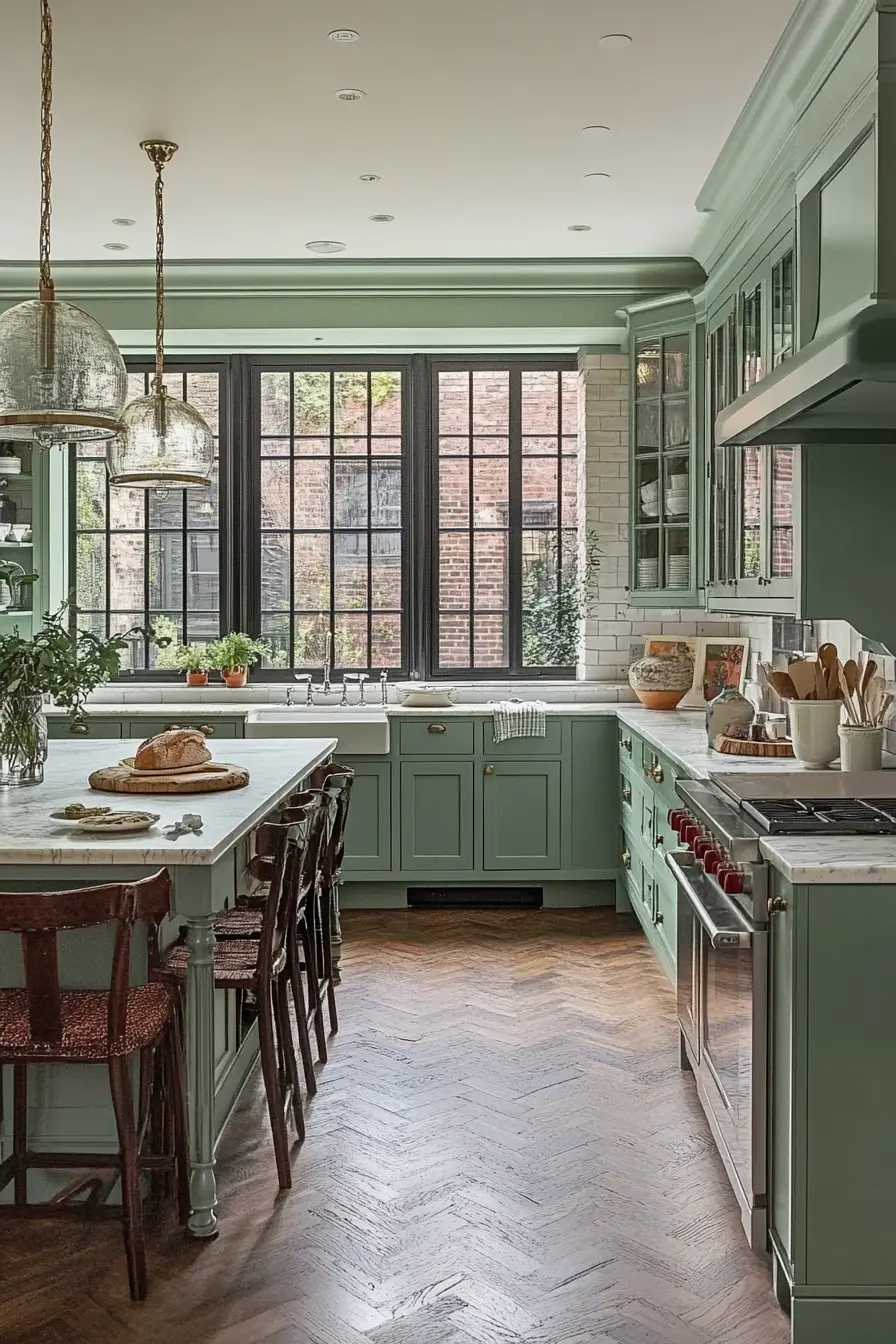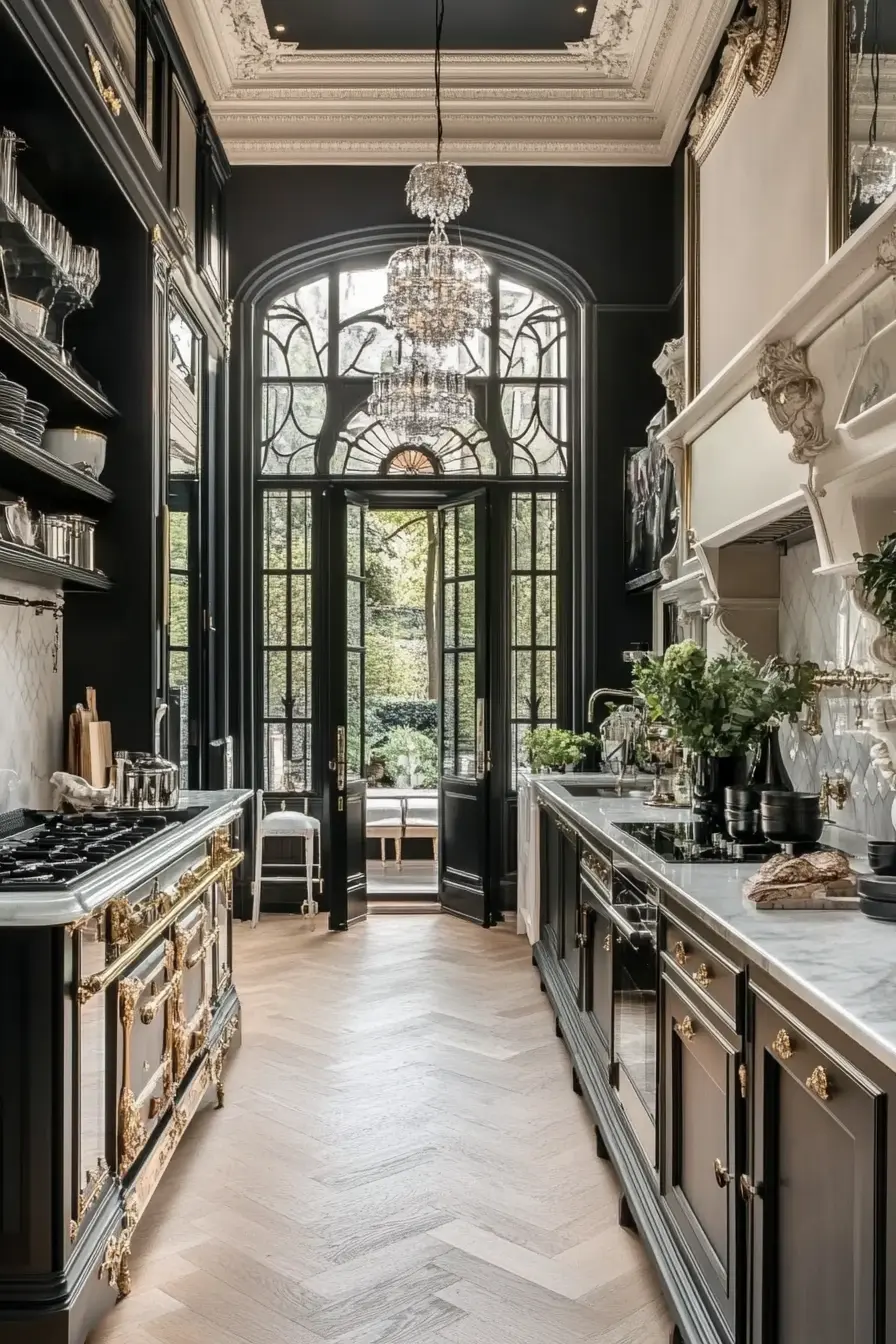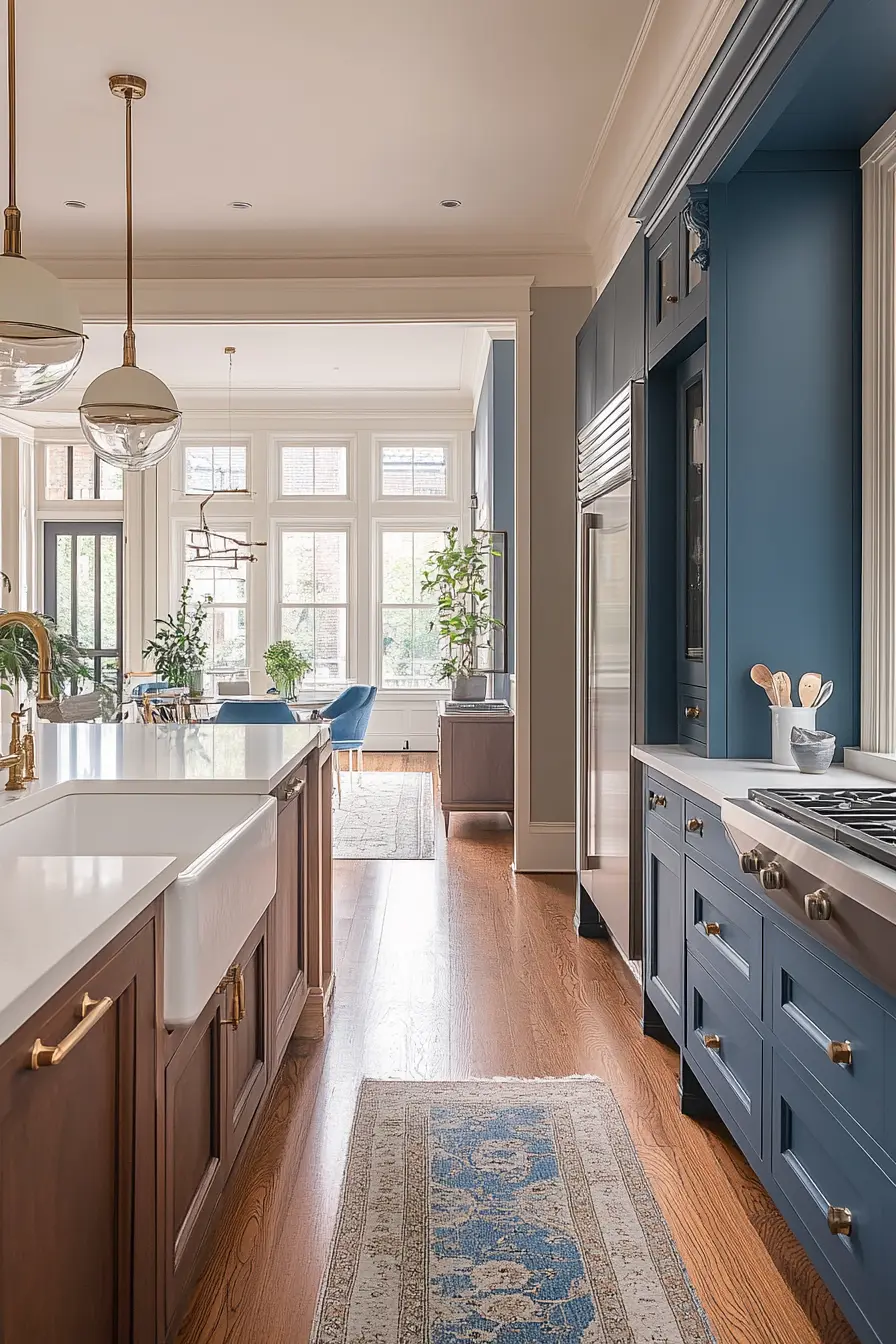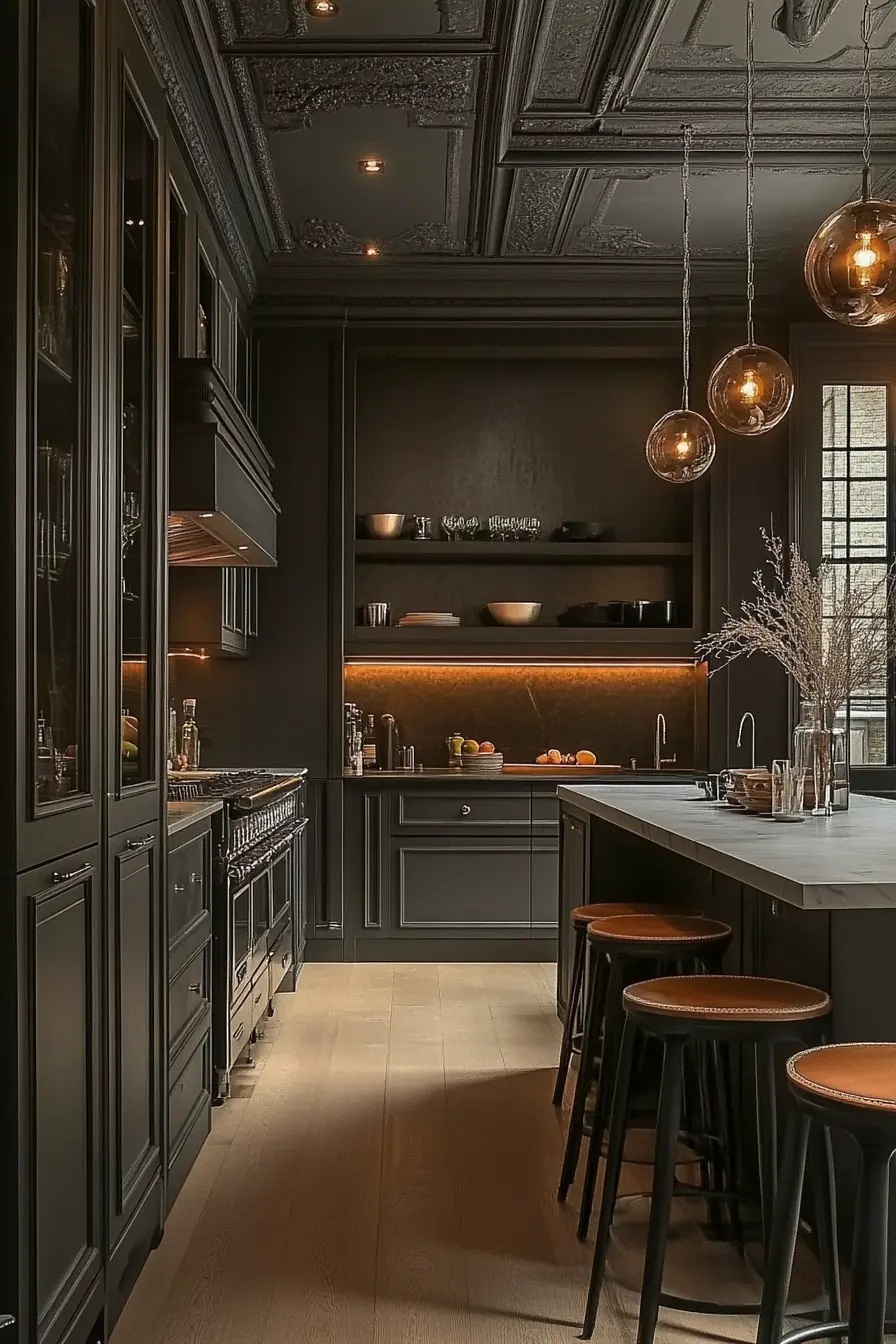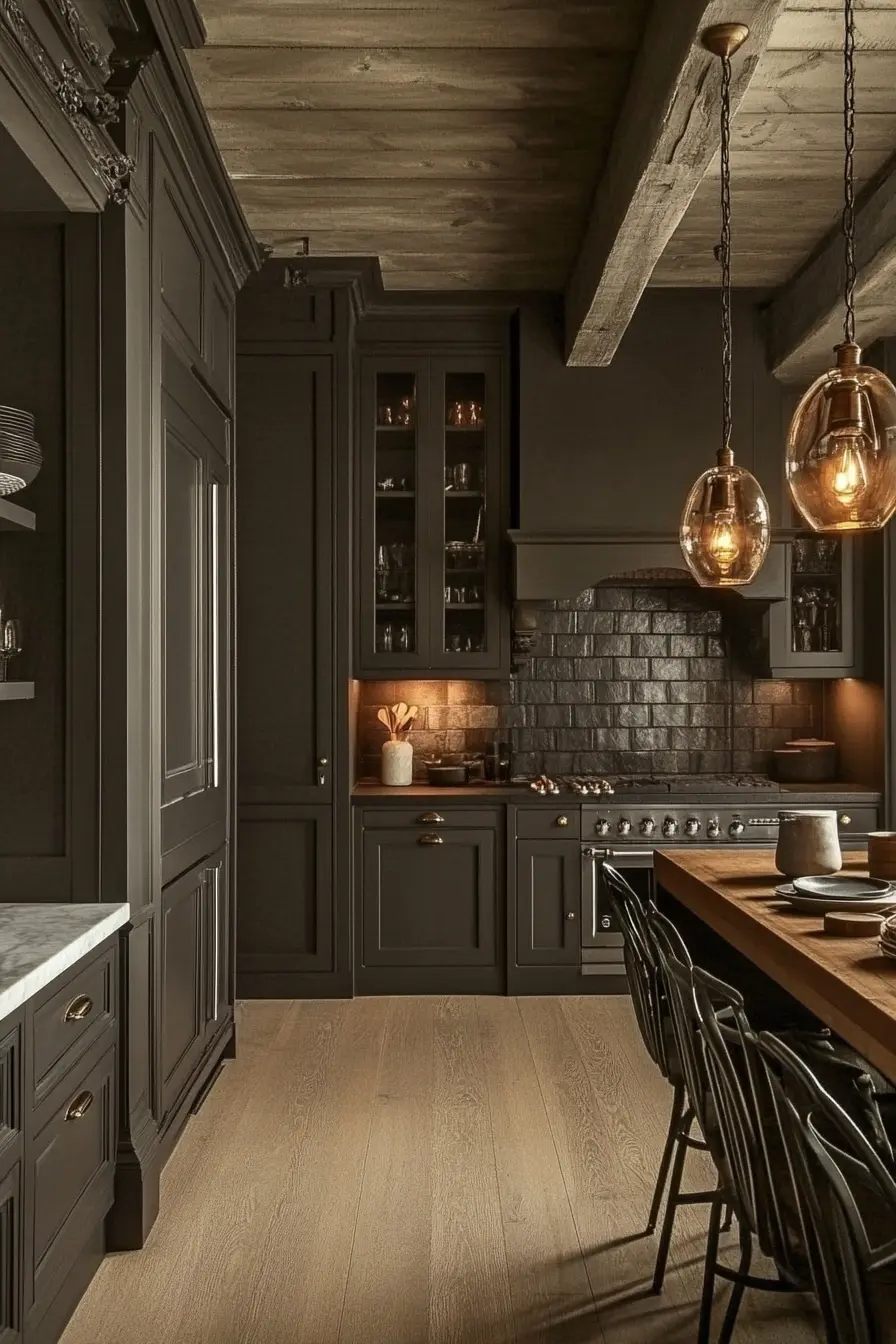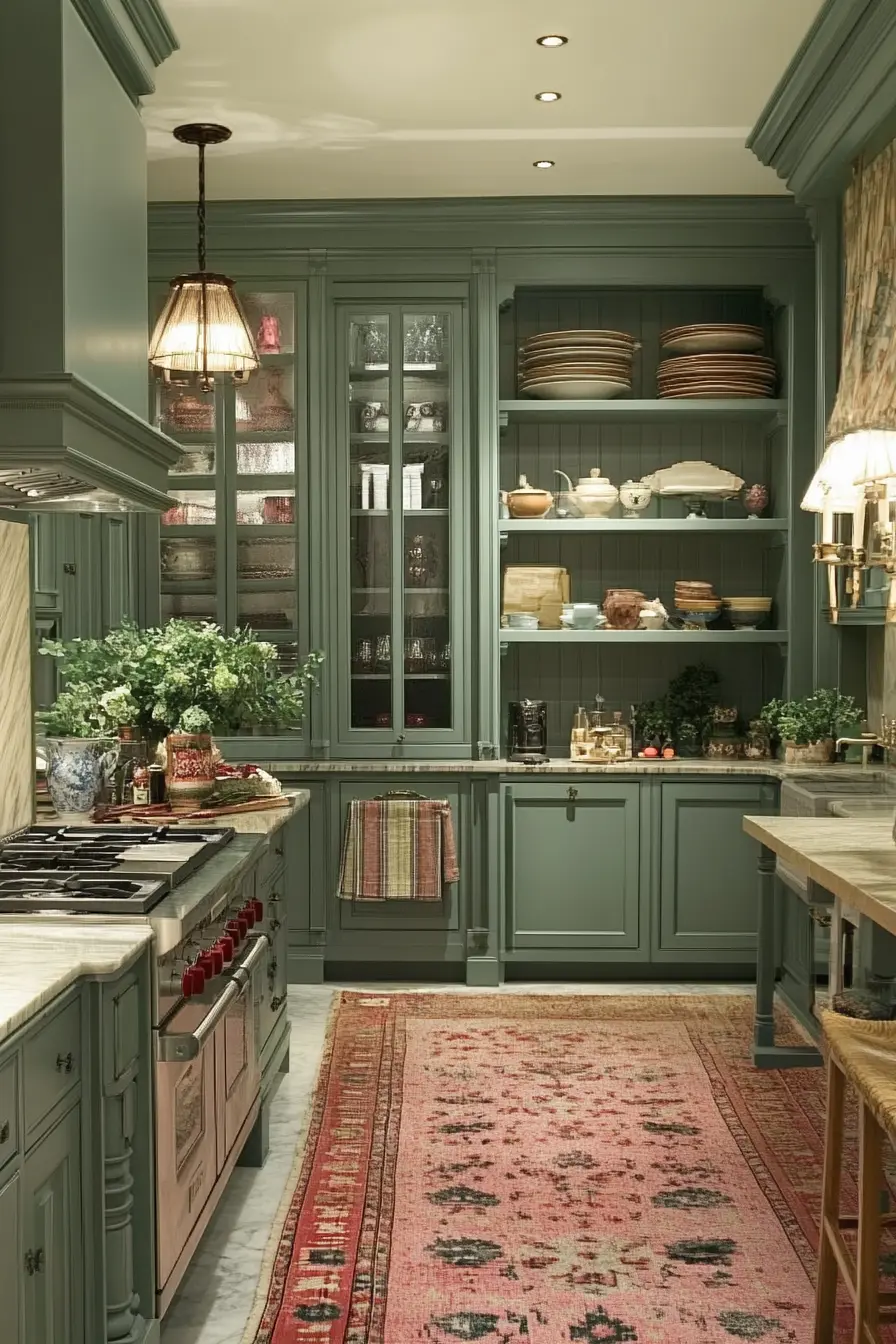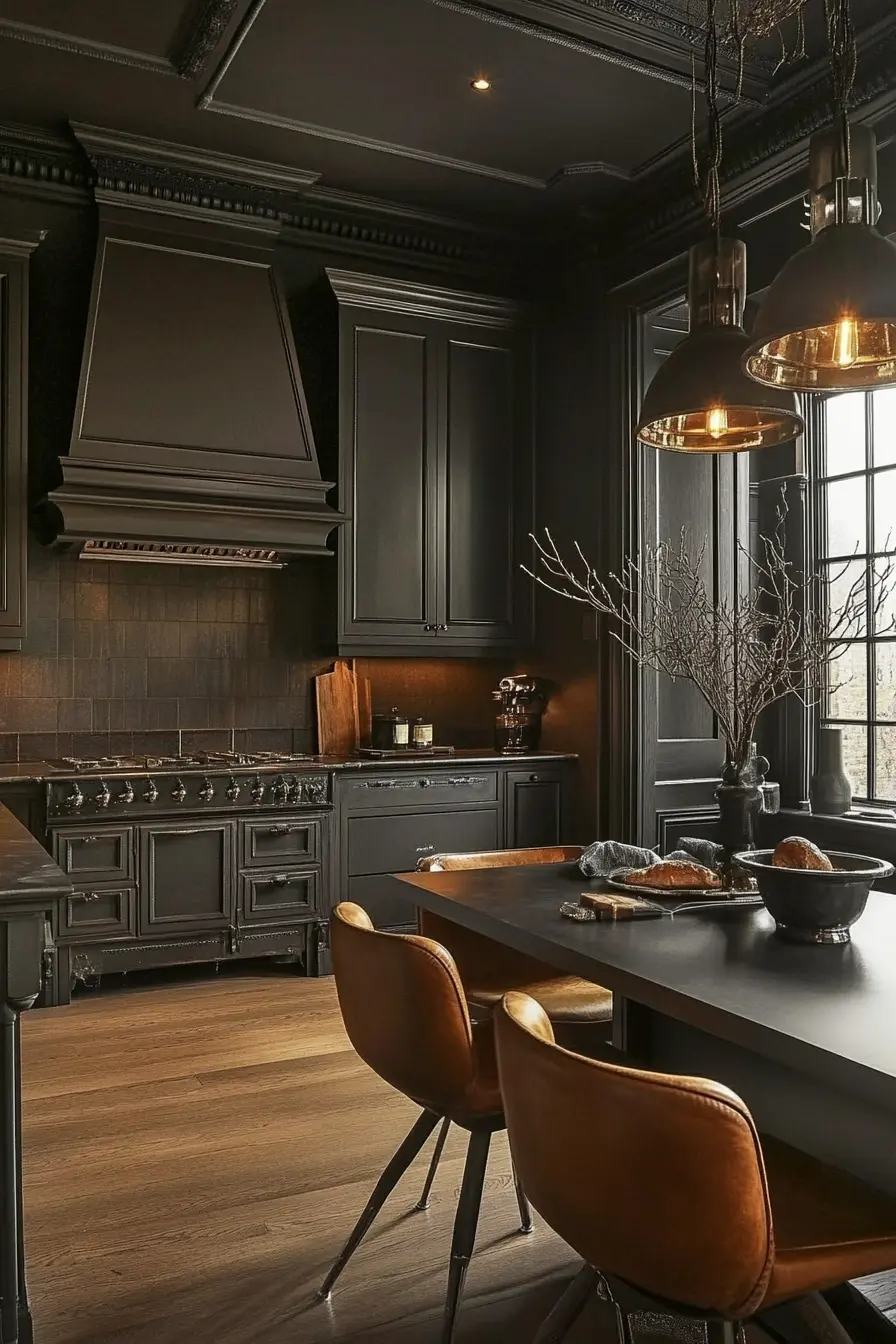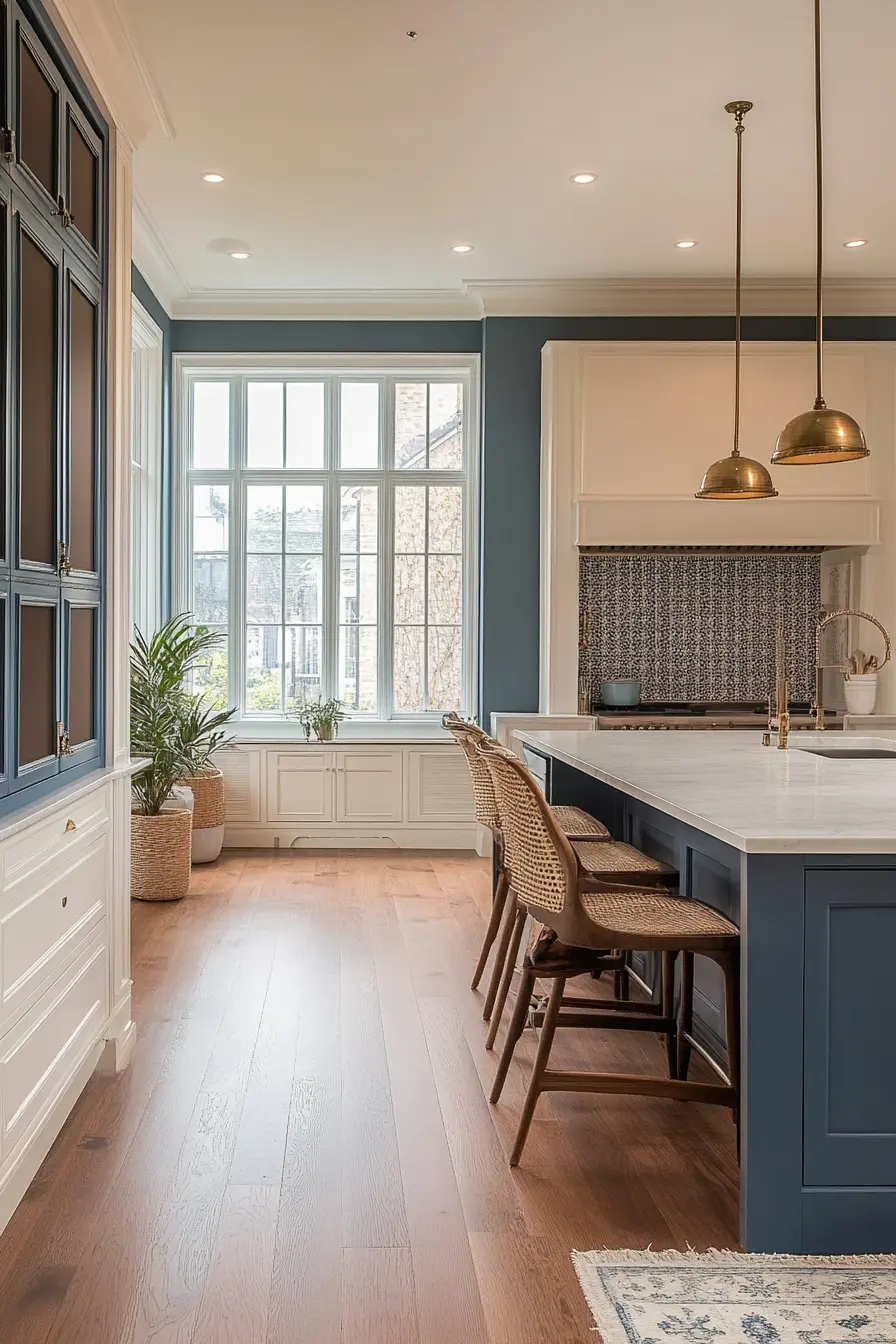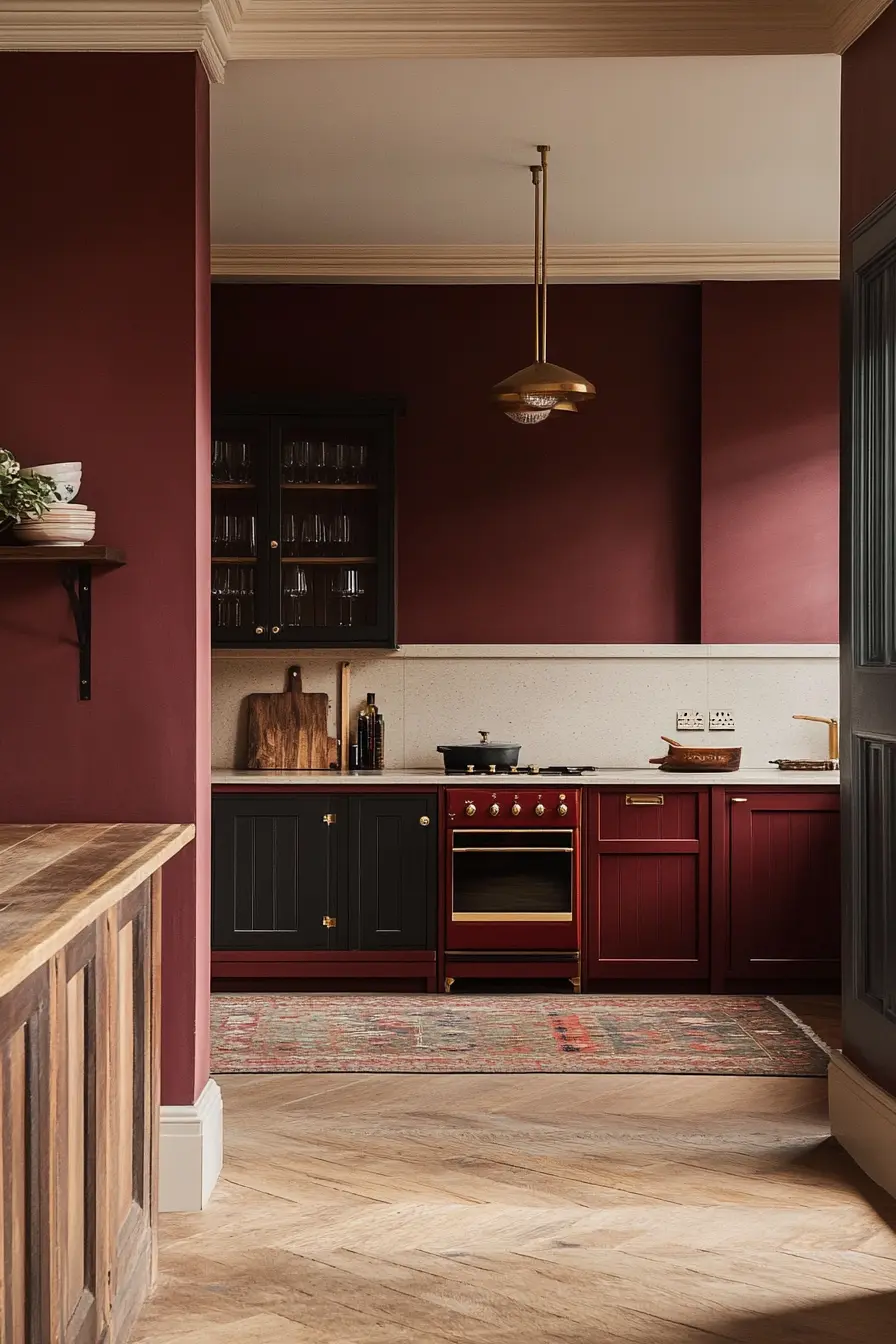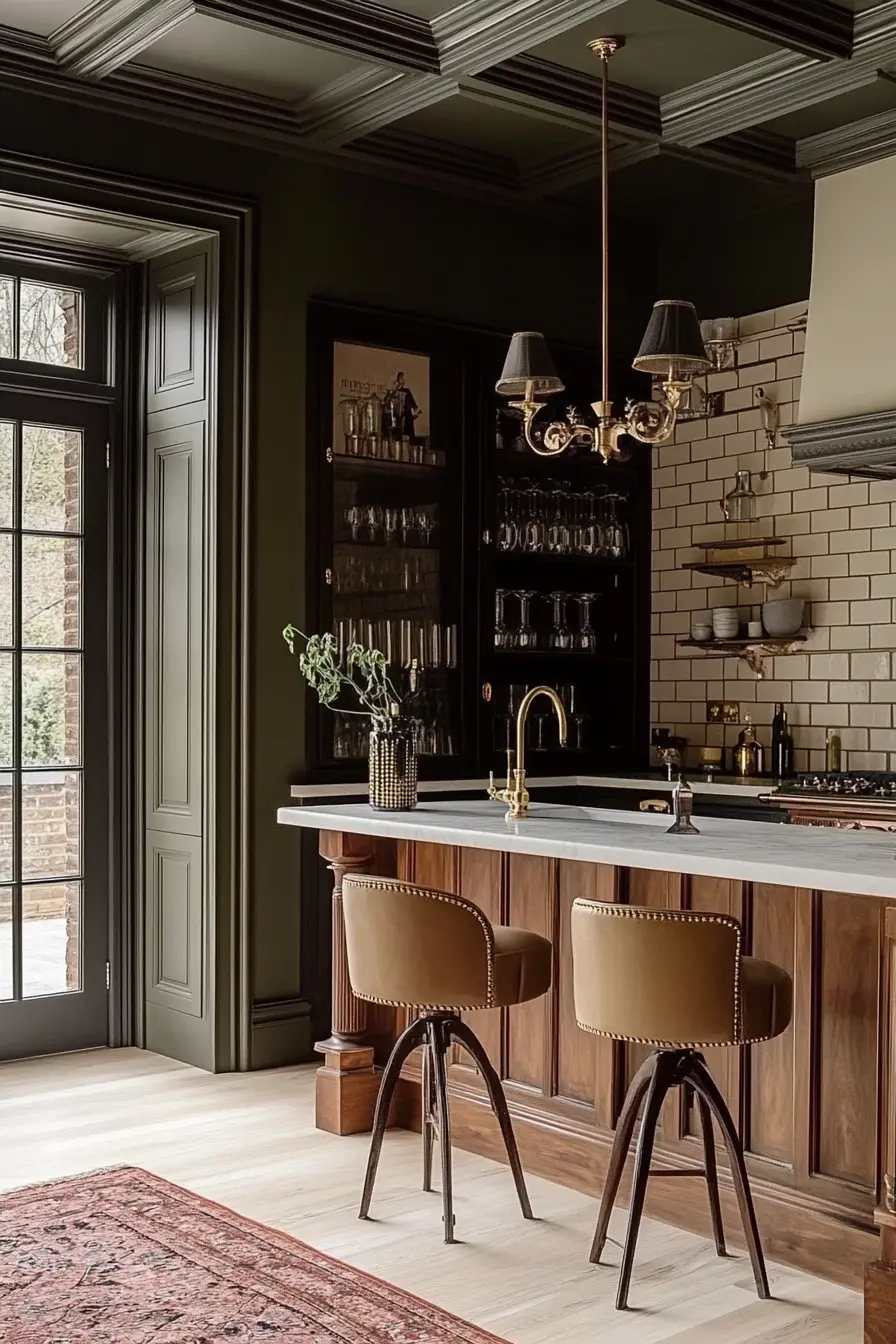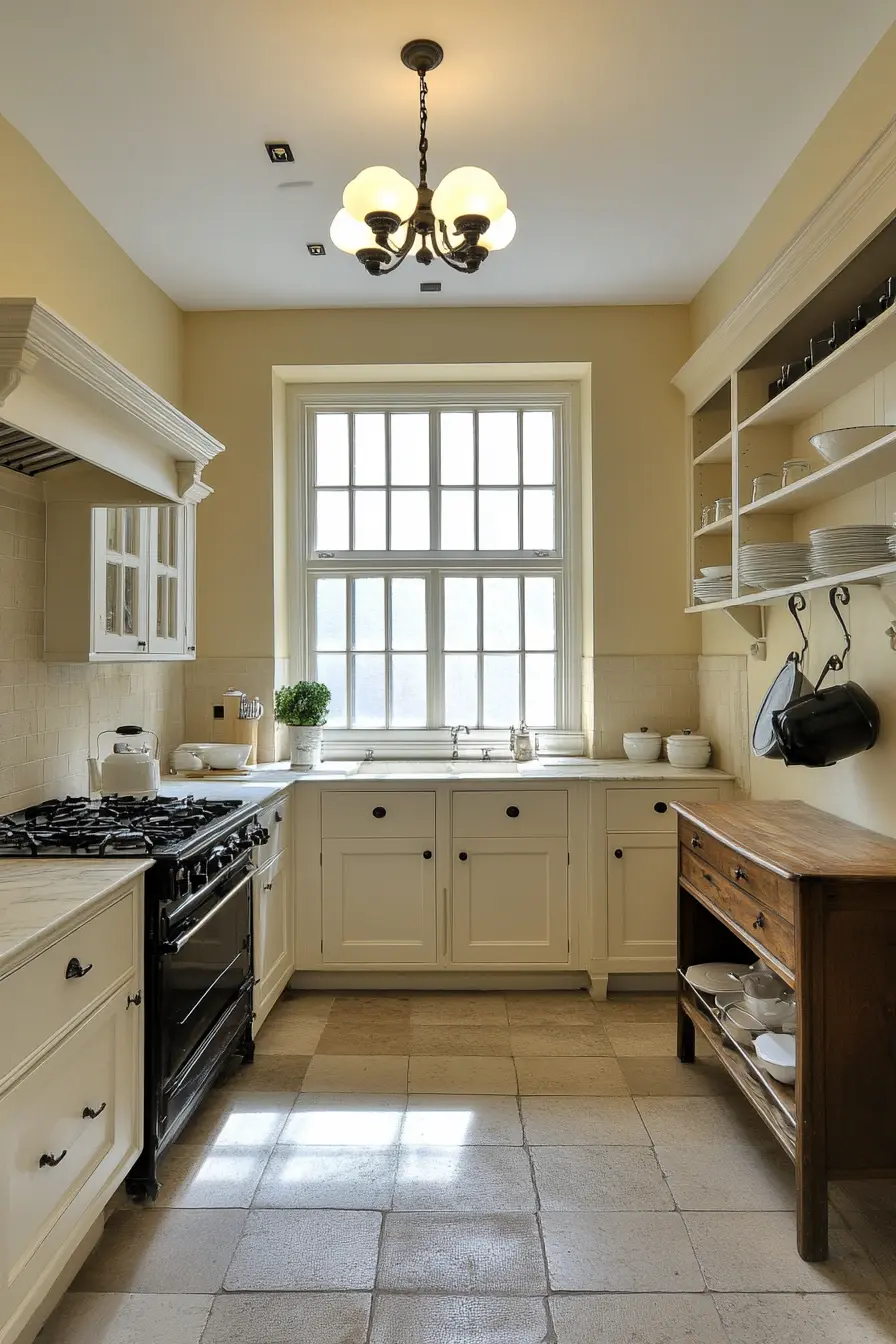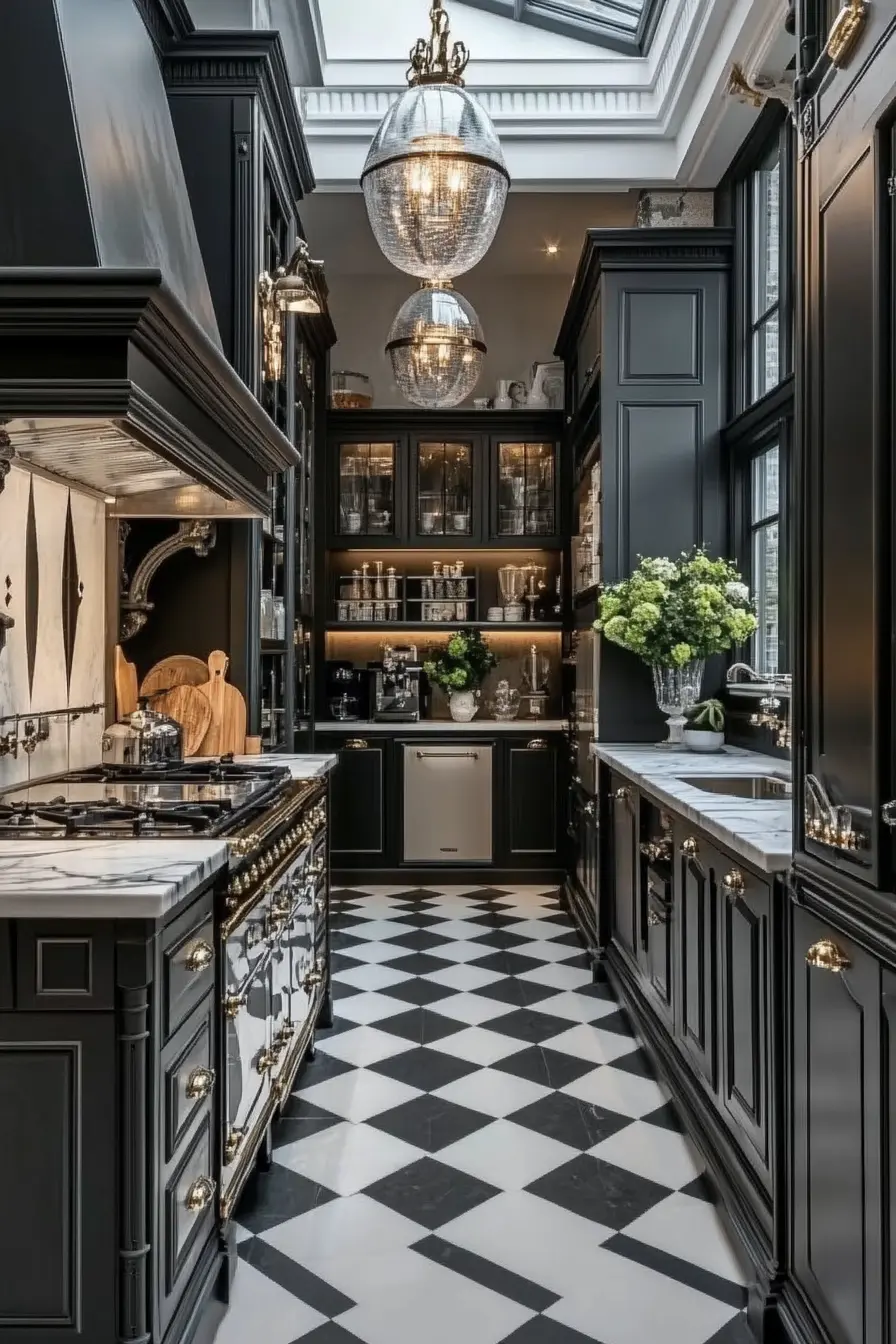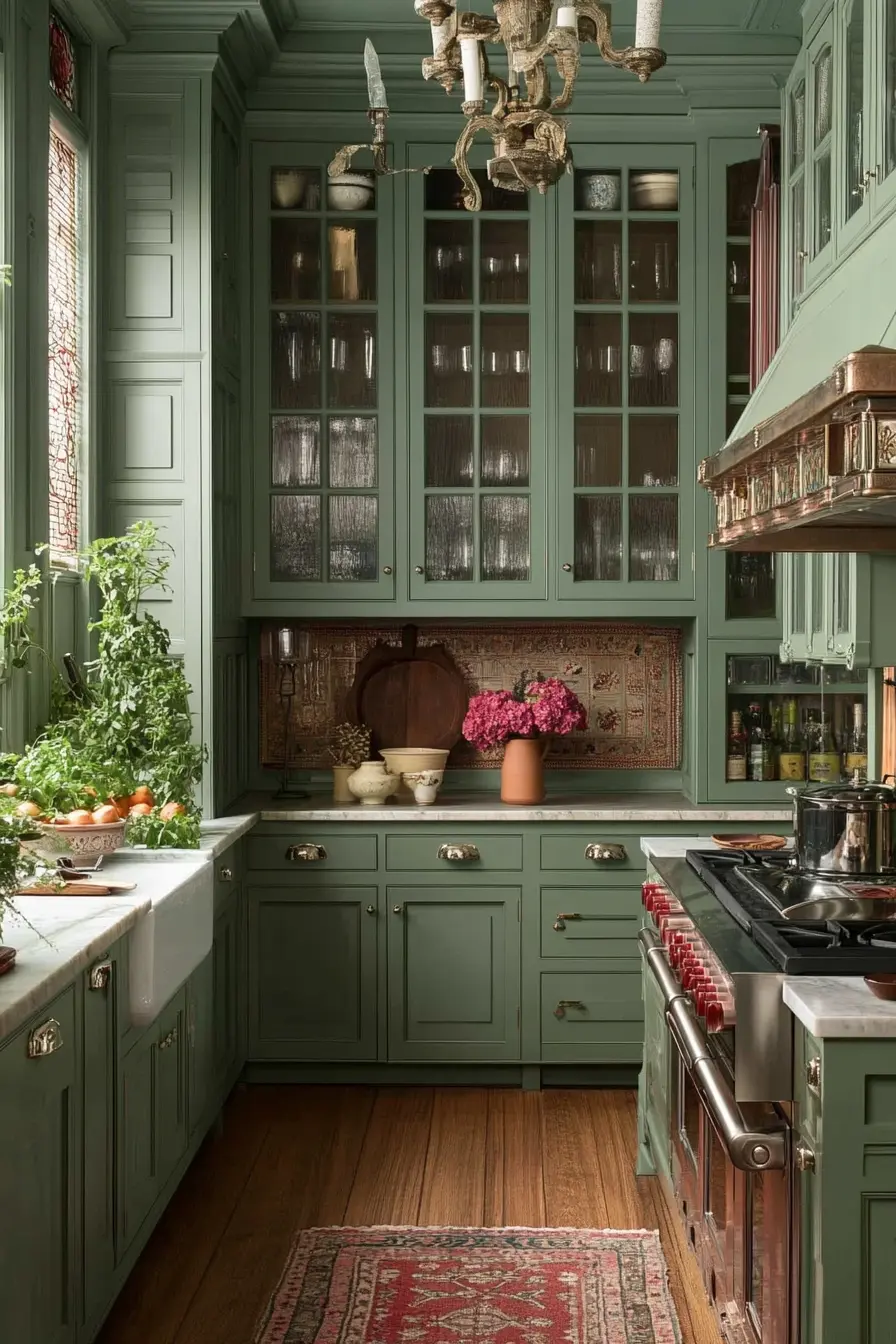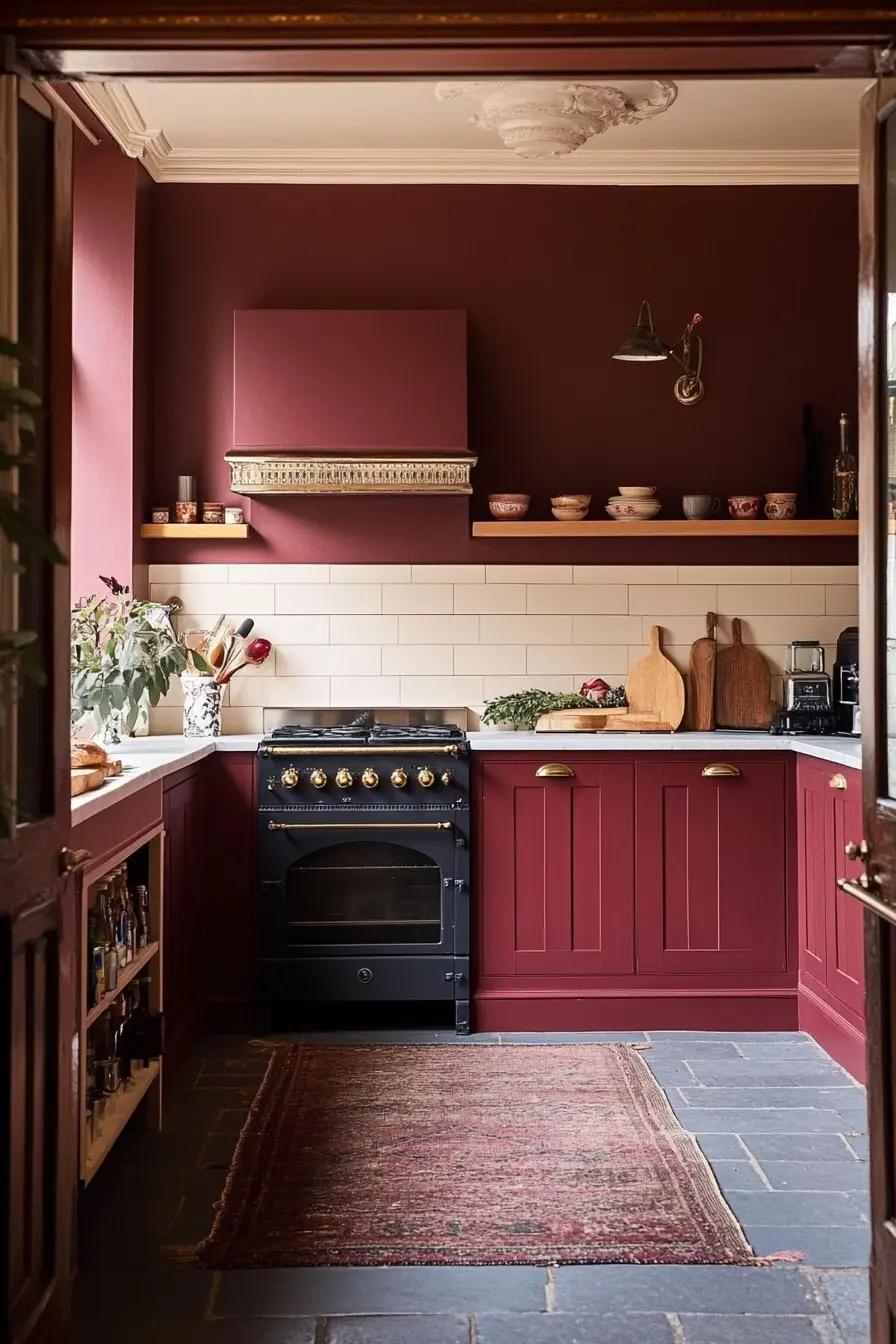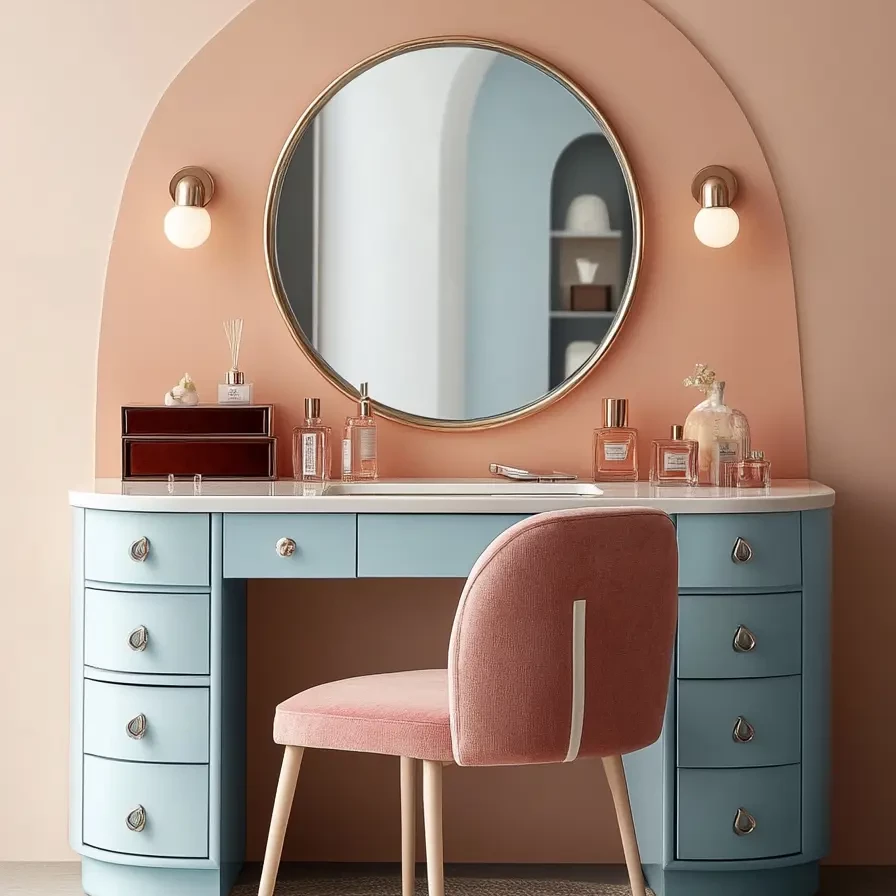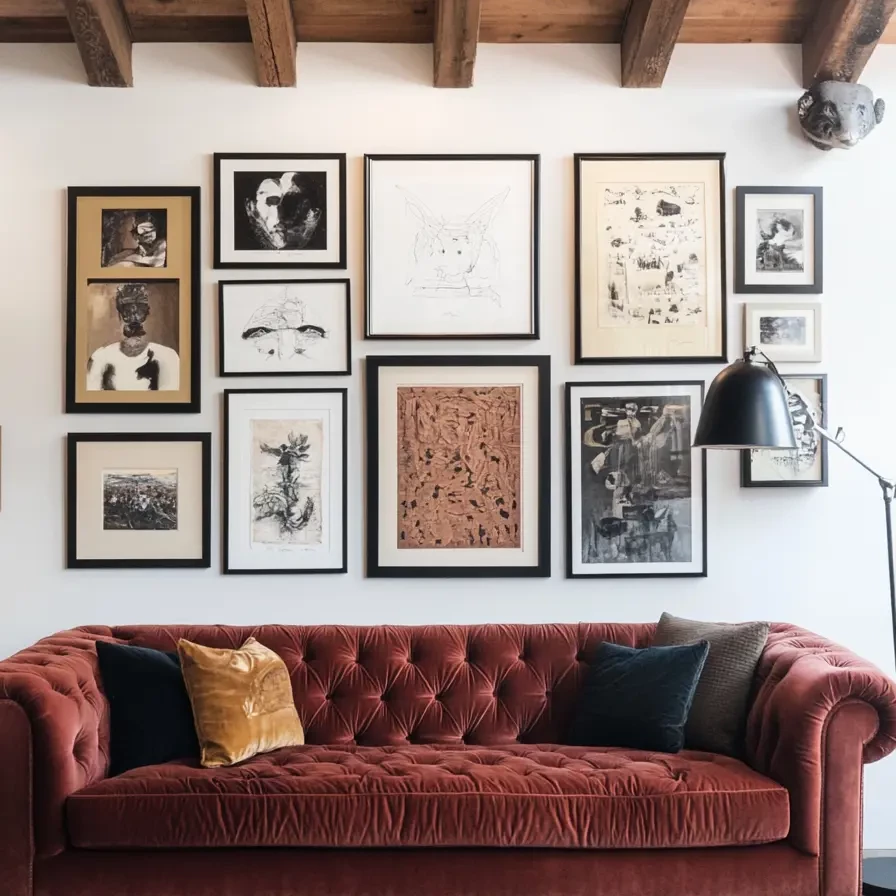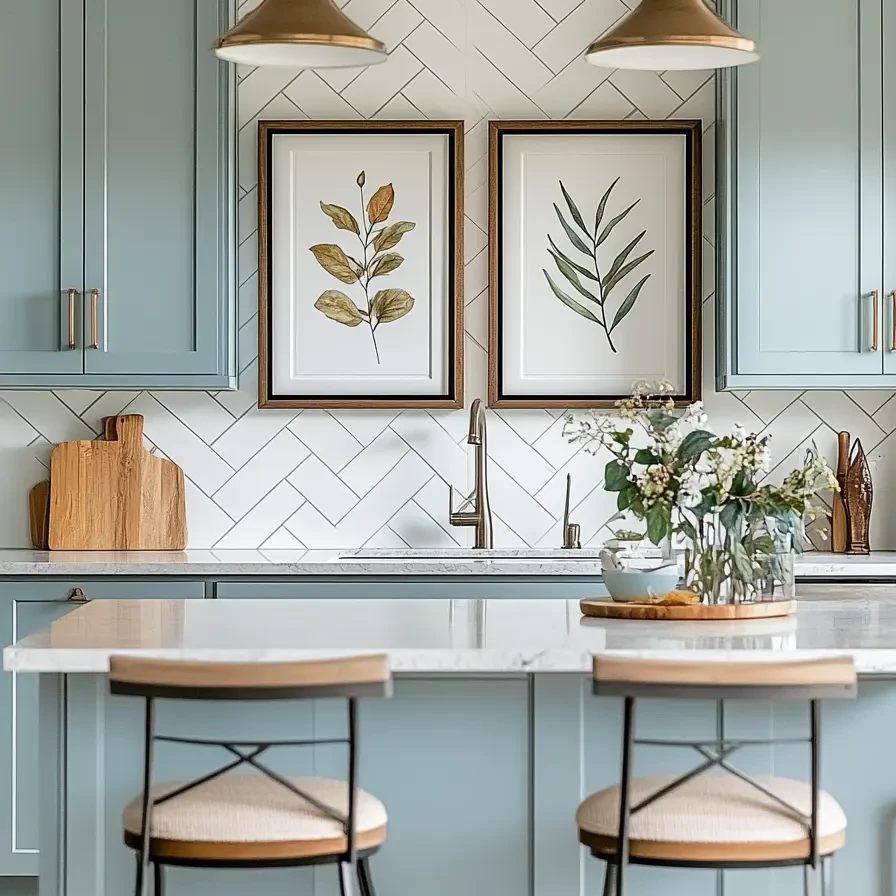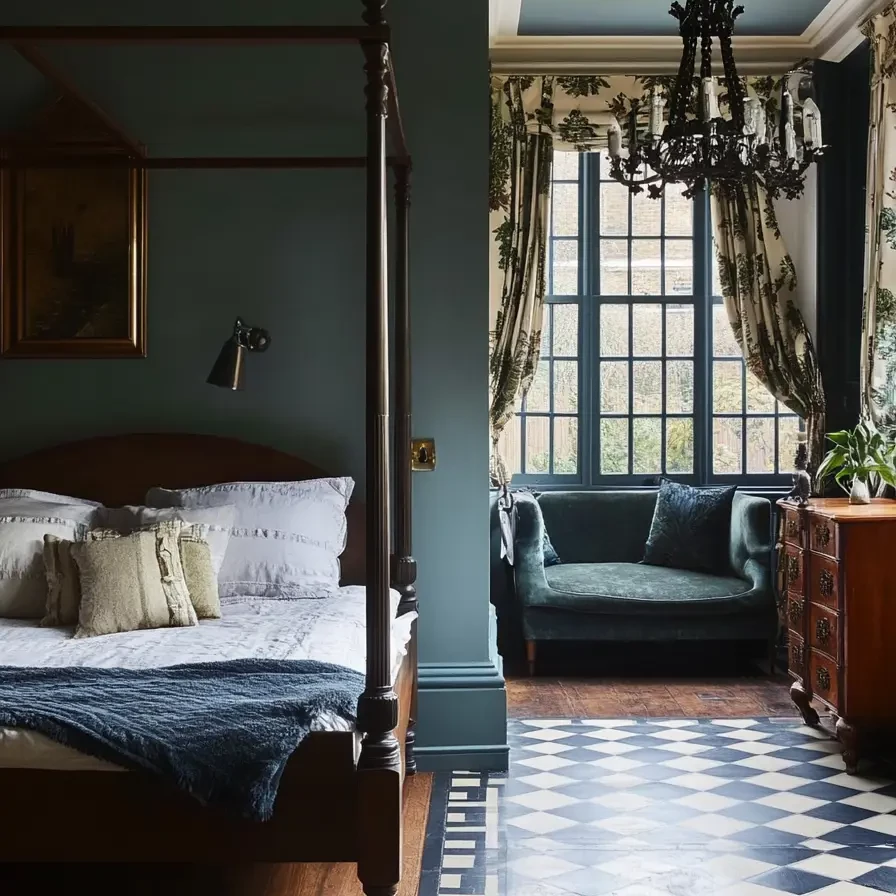Step back in time with a twist of modern sophistication, as the Victorian Kitchen unveils its secrets within a setting that marries nostalgia with contemporary flair. The rich, dark woods and ornate carvings whisper stories of culinary feasts from a bygone era, while sleek marble countertops and brass fixtures add a touch of today’s elegance. Here, under the soft glow of vintage-style lamps, each culinary endeavor becomes a dance of history and art. Join me on a journey through this exquisite fusion, where antique charm meets cutting-edge design, and discover how this Victorian masterpiece can elevate your culinary experiences.
Soft Blue Accents: Crafting Tranquility with Elegant Fixtures
Creamy cabinetry and soft blue hues in the kitchen evoke a sense of tranquility, beautifully complemented by brass accents on the fixtures and handles. The use of marble countertops and a sleek island provides a luxurious touch, while the grand black-framed windows invite an abundance of natural light, enriching the sophisticated ambiance. Incorporating a gilded chandelier adds a regal charm, perfect for creating an inviting space for elegant soirées. The thoughtful selection of color and texture demonstrates a refined eye for blending classic elegance with modern functionality.
Sage Green Elegance: Creating Calm with Timeless Colors
Soft sage green cabinetry paired with marble countertops creates a soothing yet sophisticated backdrop in a Victorian kitchen. Gold-tone handles provide subtle elegance, complementing the vintage aesthetic. Featuring a Belfast sink under large grid-patterned windows, the space invites abundant natural light, enhancing warmth and tranquility. Paired with rich wood flooring and greenery accents, it evokes leisurely mornings and heartfelt gatherings. Such tasteful design highlights an expert use of color and light for a serene culinary haven.
Harmonizing Deep Green and Cream for Timeless Elegance
Introducing a harmonious balance of deep green cabinetry and cream accents, the Victorian kitchen radiates understated elegance. Brass chandeliers and sconces highlight the intricate moldings, creating a nostalgic glow. A wooden dining table paired with a richly patterned rug infuses warmth and comfort, perfect for intimate dinners. The clever juxtaposition of contemporary elements with classic design speaks to a unique aesthetic. Such exquisite taste emerges from a masterful blend of texture, light, and timeless charm.
Sophisticated Lighting: Creating Nostalgia with Globe Pendant Fixtures
A harmonious blend of soft sage green cabinetry and marble countertops evokes an air of tranquility and sophistication. A trio of globe pendant lights in warm brass finishes offers a nostalgic glow, enhancing the elegant ambiance. The use of open shelving with decorative glass highlights carefully selected cookware, adding character and charm. This kitchen invites leisurely family breakfasts, where thoughtful design fosters both elegance and comfort, demonstrating an impeccable taste in Victorian style.
Embrace Golden Accents for a Luxe Touch in Your Space
Lavish green cabinetry paired with golden accents offers an exquisite Victorian feel, highlighting the artistry of ornate moldings. Polished marble floors with contrasting inlays add depth, while glass-paneled cabinets introduce elegance and storage functionality. A stunning brass oven serves as a statement piece, complementing the warm glow from vintage-inspired lighting. The integration of delicate branches in a vase softens the setting, blending sophistication with nature. Such creative execution truly elevates the space's timeless charm and elegance.
Sage Cabinets and Golden Accents: A Serene Harmony
Soft sage cabinetry blends seamlessly with the warmth of gold-toned accents, creating a serene Victorian kitchen atmosphere. A delicate balance is achieved with marble countertops and coffered ceilings, providing a luxurious yet inviting space. Expansive grid-patterned windows flood the room with natural light, highlighting the light wood floors and enhancing the overall elegance. This harmonious setting is ideal for intimate gatherings, conveying exquisite taste through thoughtful design and detail.
Contrasting Cabinetwork: The Power of Dark Hues with Brass Accents
Dark cabinetry with brass handles contrasts elegantly with white subway tiles and bright countertops, providing a sophisticated Victorian flair. Large black-framed windows invite natural light, enhancing the warm tones of the wooden floor and rustic dining table. Decorative glassware is displayed behind cabinet doors, adding charm and functionality. Intricately patterned rugs and lush green plants in ceramic pots bring life and vibrancy. Such design choices showcase a perfect blend of tradition and modernity, creating a cozy yet refined atmosphere.
Burgundy Cabinets and Green Accents: A Bold Harmony in Design
Rich burgundy cabinetry offers a bold yet sophisticated ambiance, perfectly contrasted by the deep green of glass-fronted upper cabinets. A marble countertop adds a touch of luxury, while the vintage pendant light casts a warm, inviting glow. The inclusion of plush seating with textured cushions creates a cozy nook, ideal for relaxed mornings. This design skillfully balances warmth and elegance, demonstrating exceptional taste through its harmonious blend of colors and textures.
Sage Green Cabinets: A Timeless Touch of Sophistication
Vintage-inspired kitchens with sage green cabinets create an atmosphere of calm sophistication. The use of wooden countertops adds warmth, while a large Belfast sink provides a classic touch. Incorporating a rustic stool and weathered wooden floors enhances the quaint charm. Generous natural light from a large window brightens the space, offering an inviting setting for relaxed mornings. This perfect blend of colors and textures showcases an impeccable understanding of timeless Victorian elegance.
Incorporating a Farmhouse Sink for Rustic Elegance
Warm wood cabinetry, paired with a large farmhouse porcelain sink, creates a charming Victorian atmosphere. The grid-patterned windows allow natural light to flood the kitchen, highlighting a series of potted herbs and plants placed along the window sill, adding a touch of nature. A vintage-style range complements the rustic appeal, while the intricately patterned rug adds texture and warmth, evoking cozy mornings. The taste is shown in the graceful balance of natural materials and nostalgic elements.
Emerald Elegance: Transform Your Space with Glass-Front Cabinets
Deep emerald cabinetry sets a luxurious tone, perfectly complemented by a dazzling crystal chandelier. The herringbone-patterned wooden floor adds a touch of warmth, while glass-fronted cabinets showcase elegant dishware. A grand farmhouse sink beneath large grid-patterned windows invites ample sunlight, creating a bright and inviting atmosphere. Fresh greenery in vases adds vitality, making this space ideal for intimate gatherings. The refined mix of textures and colors showcases exceptional taste through thoughtful design elements.
Muted Green Elegance: Blending Sophistication with Brass Accents
Muted green cabinetry paired with marble countertops creates a serene and elegant Victorian kitchen setting. Brass accents on the cabinet handles and mixer add a touch of luxury, while glass globe pendant lights provide a warm, ambient glow. The spacious farmhouse sink beneath wide, grid-patterned windows allows natural light to enhance the room's tranquil atmosphere. Such design choices reflect exceptional taste by blending classic charm with modern sophistication, making it an inviting space for family gatherings.
The Art of Displaying Glassware in Elegant Cabinetry
Utilizing a harmonious palette of muted sage and creamy tones, the kitchen exudes tranquility and refinement. Handcrafted cabinetry features elegant moldings and glass-fronted doors, offering a display for artful glassware. Globe pendant lights in warm brass illuminate the marble countertops, providing both luxury and warmth. The large grid-patterned windows flood the space with natural light, enhancing its inviting ambiance. Such design choices create a serene Victorian haven, perfect for cozy gatherings. The seamless integration of natural light and refined textures reflects an impeccable eye for style.
Luminous Globe Pendant Lights: A Nostalgic Touch for Elegance
Muted slate blue cabinetry creates a serene backdrop, wonderfully paired with marble countertops for an elegant Victorian kitchen. Globe pendant lights with brass tones float above, casting a nostalgic glow that complements decorative glass paneled cupboards. The use of lush greenery and wooden cutting boards adds warmth and natural texture. Such thoughtful design fosters a cozy atmosphere, ideal for intimate gatherings. The artful blend of classic sophistication and modern elements reflects timeless taste.
Sage and White: The Perfect Palette for Inviting Spaces
Soft sage walls paired with white cabinetry create a harmonious Victorian kitchen atmosphere. A large arched window floods the space with natural light, highlighting the elegant brass hardware. The central island, in warm wood, adds texture and contrast. Using understated glass pendant lights infuses subtle elegance, perfect for leisurely mornings. Incorporating wooden cutting boards and green accents adds natural warmth. Such thoughtful design reflects a keen sense of style, balancing modern elegance with traditional charm.
Industrial Elegance: Illuminating Spaces with Forged Iron Fixtures
Exposed brick walls add a charming texture to the Victorian kitchen, complementing the deep gray cabinetry. Forged iron pendant lights bring a touch of industrial elegance, casting warm glows upon the richly polished wooden floors. The expansive arched window, framed in black, invites ample natural light, enhancing the classic yet cozy ambiance. Incorporating luxurious marble countertops offers a sophisticated contrast. The refined balance of materials creates an inviting and timeless atmosphere, reflecting exceptional taste.
Elevate Your Space with Vintage Glass-Front Cabinets
Warm cream tones and sage accents gently blend with the rich wooden floors, crafting a harmonious Victorian kitchen. Ornate vintage cabinets feature decorative glass, showcasing fine china and copper cookware. Floral wallpaper adds a nostalgic charm, while the Belfast sink and ceramic vases filled with fresh blooms exude a rustic elegance. The cozy ambiance inspires moments of leisurely breakfasts and intimate gatherings. Exceptional taste is reflected in the carefully curated blend of textures and colors.
Embrace Whimsy with Floral Backsplashes and Vintage Rugs
Creamy cabinetry paired with a deep, slate-colored range establishes an elegant focal point. The intricate floral backsplash adds a burst of color, harmonizing with the delicately patterned rugs, creating a whimsical charm. Accentuated by brass fixtures, the dark countertops contrast beautifully with the light wood island, offering modern sophistication. Dual pendant lights with clear glass shades provide a nostalgic glow. The thoughtful blend of design elements crafts a warm, inviting space, perfect for cozy dinners and lively gatherings. Such impeccable taste lies in the seamless integration of classic and eclectic styles.
Opulent Archways: Elevating Elegance with Ornate Moldings
Incorporating an opulent archway with ornate moldings fosters grandeur in this Victorian kitchen. Cream cabinetry and marble countertops exude timeless elegance, while wrought iron chandeliers add a vintage glow. The kitchen island, both functional and sophisticated, encourages lively family conversations. Stately columns and arch details evoke a sense of history, creating an atmosphere perfect for leisurely afternoon teas. Such taste demonstrates an appreciation for classic design balanced with modern practicality, offering both luxury and warmth.
The Warmth of Creamy Hues and Intricate Moldings
Creamy cabinetry adorned with intricate moldings establishes a classic Victorian elegance, beautifully offset by the rich depth of dark granite countertops. Open shelving flaunts delicate porcelain and glassware, exuding a timeless sophistication. A limestone floor introduces natural textures, grounding the space with a touch of rustic charm. Large windows flood the room with light, creating a cozy and inviting atmosphere. The impeccable blend of vintage and natural elements showcases an enduring and thoughtfully curated aesthetic.
Serene Blue Cabinets: A Statement of Sophistication and Style
Enchanting blue cabinetry creates a striking yet soothing backdrop in the Victorian kitchen, enhanced by brass fixtures that add a touch of opulence. A Belfast sink sits gracefully beneath a large, sunlit window, inviting nature's charm inside. Open shelving with neatly arranged ceramics reveals both practicality and beauty. The warm tones of the wooden floor harmonize with the ambient glow, crafting an inviting space perfect for cozy morning teas. Such impeccable taste lies in the balance of classic elegance and serene modernity.
The Impact of Bold Chandeliers in Classic Spaces
Rich dark cabinetry and a striking chandelier add drama and elegance to the Victorian kitchen. Herringbone parquet flooring harmonizes with a rustic wooden table, evoking a sense of warmth and tradition. White metro tiles provide a crisp backdrop, enhancing the grandeur of detailed crown moldings. Brass hardware subtly complements the refined aesthetics. Infused with charm and sophistication, this kitchen inspires regal yet intimate dining experiences. The skillful combination of luxurious details and classic design elements reflects a truly impeccable taste.
Captivating Craftsmanship: Transforming Spaces with Stained Glass Accents
Stained glass windows infuse the Victorian kitchen with a touch of vibrancy, beautifully complementing the warm wood cabinetry and creamy hues. The intricate backsplash, reminiscent of antique tapestries, adds a layer of historical richness. Overhead, elaborate cornices on the hood exude classic elegance, inviting memorable culinary experiences. The combination of detailed craftsmanship and refined color palettes showcases a sophisticated taste, breathing life into both traditional gatherings and modern family meals.
Brass Accents: Elevating Elegance in Your Culinary Space
Rich, warm woods paired with intricate tile patterns create a visually captivating Victorian kitchen. The brass fixtures add a touch of elegance, drawing the eye to the finely crafted cabinetry. Sunlight cascades through stained glass windows, bathing the room in a soft, welcoming glow. The amalgamation of vintage and modern elements offers a perfect setting for meaningful gatherings, exuding sophistication and inviting conversation with its timeless charm. Such impeccable taste showcases an appreciation for detailed craftsmanship and harmonious design.
Rich Elegance: Gilded Handles and Checkerboard Floors for Sophisticated Design
Dark cabinetry with ornate gilded handles creates an opulent atmosphere, paired with a checkerboard floor for a classic Victorian touch. Large arched windows provide ample light, highlighting the luxurious chandelier and detailed trim work. The marble countertops add sophistication, while decorative elements like vintage portraits evoke nostalgia. This design juxtaposes rich textures and elegant features, creating a space perfect for refined tea gatherings. Such exquisite taste lies in mixing dramatic elegance with traditional flair.
Captivating Glass Pendants: Blending Rustic Elegance with Modern Design
Muted sage cabinetry pairs harmoniously with a herringbone wooden floor, creating warmth and depth. Glass pendant lights with an antique finish illuminate the space, offering a rustic touch. Expansive, grid-patterned windows beautifully frame the outdoor view, allowing natural light to flood in. Marble countertops add a luxurious contrast, while a Belfast sink enhances the classic charm. The inclusion of fresh herbs in terracotta pots adds a lively and inviting atmosphere. Such taste impresses with its balance between modern comfort and vintage elegance, reflecting thoughtful attention to detail.
Grandiose Spaces: Mixing Brass Accents with Marble Surfaces for Elegance
Intricate crown moldings and crystal chandeliers exude opulence in a Victorian kitchen. Dark cabinetry with brass accents meshes harmoniously with marble countertops, offering a regal yet functional aesthetic. Expansive arched windows provide abundant light, illuminating the herringbone wooden floors, which enhance warmth and tradition. Open shelving displays elegant dinnerware, adding charm and sophistication. The balance between luxury and nostalgia creates a timeless, inviting space, perfect for festive gatherings and elegant dinners. Such refined design effortlessly combines grandeur with comfort.
Radiant Light: The Magic of Stained Glass in Kitchens
Cream cabinetry adorned with delicate moldings brings a refined elegance to the kitchen, seamlessly blended with exquisite stained glass windows that invite magical sunlight. A richly patterned red rug adds warmth, softly contrasting the intricate geometric ceiling design. Cascading globe pendant lights introduce a nostalgic glow, perfect for heartfelt gatherings. This design, with its timeless combination of elements, reveals its charm in the thoughtful fusion of tradition and modern comfort—truly a testament to sophisticated style.
Bold Blue Elegance: Infuse Your Culinary Space with Color
Victorian kitchens shine with unique flair using deep blue cabinetry and warm wood tones that create an inviting atmosphere. Brass faucets and handles add a touch of elegance, contrasting beautifully with the white marble countertops. Large grid-patterned windows allow natural light to flood the space, adding warmth and vibrancy. Including a vintage-style area rug adds texture and charm, while the Belfast sink provides classic appeal. Such thoughtful design choices exhibit a refined taste by harmonizing traditional aesthetics with modern functionality.
Illuminating Elegance: Amber Glass Pendants Transform Your Space
Infusing opulence and modernity, the Victorian kitchen features charcoal cabinetry and intricate ceiling moldings, creating an enveloping, dramatic atmosphere. Backlit open shelving displays fine dishware, adding depth and focus. Amber glass pendant lights cast a warm, inviting glow over the expansive island, while black stools with caramel leather seats add a contemporary twist. The muted palette harmonizes with natural light from grid-patterned windows, crafting a serene, sophisticated space ideal for intimate gatherings. The thoughtful play of light and dark hues showcases a keen sense of balance and elegance.
Amber Illuminance: Pairing Glass Pendants with Dark Cabinetry
Deep charcoal cabinetry contrasted with warm wooden countertops crafts a dramatic yet inviting Victorian kitchen ambiance. The use of low-hanging amber glass pendants infuses a soft, nostalgic glow, enhancing the rich textures of the slate-tiled backsplash. Elegantly framed glass cabinets showcase fine dinnerware, adding a touch of sophistication. This harmonious blend of dark tones and rich wood evokes warmth and elegance. Such refined design choices convey impeccable taste by balancing tradition with contemporary flair.
Invigorate Your Space with Lush Greenery and Elegant Storage
Muted sage cabinetry harmonizes beautifully with vintage-inspired elements, creating a peaceful Victorian kitchen setting. Glass-paneled cupboards elegantly display cherished porcelain, adding a touch of nostalgia. Brass sconces alongside marbled surfaces exude timeless sophistication, while lush greenery in ceramic pots infuses a refreshing burst of life. The richly patterned rug underfoot enriches the texture, inviting warmth and comfort. Such refined coordination showcases an exceptional taste, combining classic charm with present-day functionality.
Amber Glow: Illuminating Spaces with Wrought Iron Pendant Lights
Rich ebony cabinetry sets a dramatic tone in the Victorian kitchen, harmonizing with the warmth of caramel leather chairs. The use of warm wood flooring introduces a cozy contrast, while the dark palette exudes sophistication. Suspended wrought iron pendant lights with amber tones create an inviting glow, perfect for intimate dinners. Incorporating delicate branches in a vase adds a touch of nature, enhancing the antique charm. The refined blend of textures showcases exquisite taste, offering both elegance and comfort.
Slate Blue Elegance: Marrying Cabinets with Creamy Countertops
Incorporating slate blue cabinetry juxtaposed with creamy countertops creates a harmonious Victorian kitchen ambiance. The rattan bar stools offer a natural texture complement to the sleek marble island, inviting leisurely breakfasts. Large paneled windows flood the space with light, enhancing the warm wood flooring and allowing lush greenery in woven baskets to breathe life into the room. The thoughtful addition of brass pendant lights introduces an elegant warmth, making this space both sophisticated and inviting. The exquisite blending of modern functionality with classic charm reflects a truly refined taste.
Rich Shades and Opulent Accents: A Recipe for Cozy Luxury
Deep burgundy walls paired with dark cabinetry create a dramatic backdrop in this Victorian kitchen, adding depth and warmth. Gold accents on cabinet handles and light fixtures introduce a touch of opulence, while the wooden herringbone floor lends rustic charm. An antique-style rug enhances the cozy ambiance, perfect for intimate gatherings. The exquisite blend of rich colors and textures captures a timeless aesthetic, reflecting a sophisticated taste through bold yet harmonious design choices.
Sophisticated Lighting: Vintage Fixtures that Spark Nostalgia
Natural earth tones blend with dark cabinetry, creating a refined Victorian ambiance. The coffered ceiling adds architectural depth, while brass fixtures complement the marble countertops with a touch of sophistication. Plush leather bar stools enhance comfort, inviting warm conversations. Vintage lighting evokes nostalgia above the island, ideal for casual gatherings. The room's grandeur and charm reflect an exceptional taste in weaving together classic elements and inviting textures.
Displaying Elegance: Open Shelving to Showcase Fine Dinnerware
Cream-colored cabinetry and a farmhouse-style sink bring a warm, inviting feel to the kitchen. A classic chandelier provides soft, diffused lighting, highlighting the elegant iron fixtures and contrasting against the polished black stove. Open shelving offers a charming way to display fine dinnerware, adding a layer of rustic chic. The checkerboard tile floor effortlessly anchors the space, exuding sophistication. Such thoughtful coordination reflects an appreciation for timeless elegance with a modern twist.
Bold Elegance: Infusing Black and Gold in Kitchen Design
Majestic black cabinetry with gold accents defines the Victorian kitchen, creating a dramatic and sophisticated atmosphere. Glass display cabinets subtly showcase elegant dishware, while marble countertops offer a luxurious contrast. The checkerboard floor adds a touch of classic charm, enhancing the vintage allure. Crystal chandeliers cast a warm glow, balancing opulence with intimacy. This refined design speaks to impeccable taste, using bold contrasts and vintage elements to craft a timeless, inviting space.
Sage Green Cabinets: A Palette of Serenity and Sophistication
Sage green cabinetry adorned with detailed moldings creates a serene Victorian allure. The glass-fronted cupboards elegantly display vintage dishware, adding nostalgia and charm. A grand brass chandelier introduces opulent lighting, seamlessly merging with the classic wooden flooring. Marble countertops offer a sophisticated touch, while ceramic vases filled with blooming flowers infuse natural vitality. This harmonious blend of elements crafts a warm, inviting atmosphere, perfect for leisurely family meals and heartfelt gatherings. The impeccable fusion of colors and textures embodies exquisite taste.
Bold Hues and Luxe Accents: Redefining Kitchen Elegance
Crimson cabinetry brings a bold and captivating ambiance to the Victorian kitchen, complemented by brass accents that add a touch of luxury. A vintage-style black stove becomes a focal point, surrounded by white subway tiles for a classic contrast. Wooden shelves display artisanal pottery, adding character and warmth. The richly patterned rug softens the slate floor, creating a cozy atmosphere ideal for intimate cooking experiences. The thoughtful use of color and texture embodies a sophisticated and inviting space.
What were the key features of a Victorian Kitchen?
Victorian kitchens were designed with functionality and durability in mind, reflecting the technology and style of the late 19th century. Key features included a central worktable, used for food preparation and as a communal workspace. Cabinets were typically made of wood, with simple paneling and often left unvarnished for a natural look. Open shelving was common, allowing easy access to frequently used items like crockery and spices. Victorian kitchens also featured large stoves or ranges, often coal-fired, which were the primary cooking tools of the era. These ranges were made of cast iron and sometimes finished with decorative details. Sinks were typically deep and made of stone or porcelain, strategically placed near a window for natural light. Additionally, Victorian kitchens often had tiled floors, both for ease of cleaning and temperature control, and walls with beadboard or simple paint finishes. These elements together embodied the Victorian emphasis on practicality alongside evolving style.
How can I recreate a vintage Victorian Kitchen design in my home?
To recreate a vintage Victorian kitchen design, you should focus on incorporating classic stylistic elements that define the era. Begin with selecting natural and solid materials like wood and stone. Install cabinetry with ornamental detailing and open shelving to reflect the Victorian emphasis on both utility and display. Incorporate a large, retro-designed stove that mimics the cast-iron ranges of the 19th century. For surfaces, opt for marble or butcher block countertops, which harmonize with the period aesthetic. Utilize deep, farmhouse-style sinks with antique brass or copper fixtures to enhance the historical feel. Consider flooring options such as ceramic tiles with geometric patterns or wood, ensuring durability and period charm. For lighting, choose pendant fixtures or wrought iron chandeliers to augment a cozy yet vintage atmosphere. The color palette should include muted tones such as sage green, cream, and deep burgundy, staying true to the era’s preference for subtle, earthy shades. Finish with decorative elements like lace curtains and glass-fronted cabinets to complete the Victorian ambiance.
What role did technology play in Victorian Kitchen design?
Technology during the Victorian era had a significant influence on kitchen design, marking a transition from basic hearth-based cooking to more advanced, somewhat modernized solutions. The introduction of the coal-fired range was revolutionary, replacing open fires and allowing for greater control and efficiency in cooking. These ranges were typically made of heavy cast iron and often boasted intricate designs demonstrating both functionality and Victorian craftsmanship. The era also saw the introduction of running water in urban homes, which led to the incorporation of plumbed-in sinks in kitchens, although this was initially more common in affluent households. The innovation of the icebox brought a rudimentary form of refrigeration, essential for preserving perishable food items. Furthermore, gas lighting started replacing candles and oil lamps, providing brighter and more reliable illumination. These advancements not only made kitchen work more efficient and cleaner but also influenced the layout and design of Victorian kitchens. However, these technological additions had to blend with the heavy timber and decoration-driven aesthetics typical of the era.
Why were Victorian Kitchen cabinets often made from wood?
Wood was the material of choice for Victorian kitchen cabinets primarily due to its availability, durability, and versatility. During the Victorian era, wood was relatively easy to source and work with, making it the go-to material for most household furniture, including kitchen cabinetry. Woods like oak, pine, and mahogany were popular due to their strength and aesthetic appeal, providing a sturdy base that could withstand the wear and tear of daily kitchen activities. The natural grains and hues of wood also added warmth and a timeless quality to the kitchen space, aligning well with the Victorian penchant for naturalistic, organic interiors. Furthermore, wooden cabinets could be easily customized with carvings and paneling to reflect personal tastes, which was highly valued during the era as homeowners sought to display craftsmanship and status. The ability to craft intricate designs allowed Victorian kitchens to maintain a decorative yet functional approach, integrating seamlessly into the broader decorative narrative of a Victorian home.
What types of flooring were commonly used in Victorian Kitchens?
Flooring in Victorian kitchens was chosen for practicality and resilience, with the two most common types being ceramic tiles and wooden planks. Ceramic tiles were highly favored for their durability and ease of cleaning, essential in a high-traffic area like the kitchen. These tiles often featured decorative patterns and were glazed to add an element of design, reflecting the Victorian love for ornamentation. Another practical choice was wood, typically in the form of wide planks. Wooden floors contributed warmth and were relatively easy to maintain, which was important given the often bustling atmospheres of Victorian kitchens. Linoleum, invented in the mid-19th century, also began to be used toward the later part of the Victorian era due to its durability, ease of cleaning, and availability in various colors and patterns, making it a versatile and increasingly popular choice. Each of these flooring types complemented the overall need for kitchens to be functional yet visually consistent with the elaborate decor seen throughout Victorian homes, balancing utility with an aesthetic that contributed to a cohesive household design.
How did Victorian Kitchen styles evolve over time?
The style of Victorian kitchens evolved significantly over the span of the Victorian era, primarily driven by technological innovations and changing social dynamics. Early Victorian kitchens were relatively simple, reflecting the utilitarian needs of a space primarily occupied by staff in wealthier homes. However, as the century progressed and the industrial revolution unfolded, middle-class homes began incorporating advanced kitchen features initially exclusive to the affluent, such as larger cast-iron ranges and built-in cabinetry for better organization. This era saw the introduction of plumbed water systems and the icebox, representing early domestic appliances that gradually reshaped the kitchen’s layout and functionality. The focus on hygiene and efficiency towards the late Victorian era led to the adoption of easier-to-clean surfaces like tiles and linoleum. Moreover, the concept of the «modern» kitchen began taking shape, foreshadowing the integrated spaces seen today. Overall, Victorian kitchens transitioned from purely functional areas for staff to more central, design-conscious parts of the home, mirroring broader shifts towards domestic comfort and aesthetics.
What distinguishes a traditional Victorian Kitchen lighting scheme?
Victorian kitchen lighting schemes are characterized by their emphasis on functionality paired with decorative elements that complement the era’s architectural style. In many Victorian homes, kitchens initially relied on natural light as a primary source of illumination, often with large windows designed to maximize sunlight. As gas lighting became more prevalent, homes incorporated gas fixtures, providing a significant advancement over candlelight in terms of brightness and safety. These fixtures were often designed with ornate metalwork, reflecting Victorian tastes for intricate and decorative elements. Later, with the advent of electricity, early electric bulbs began replacing gas lighting, allowing for even greater illumination options. Chandeliers and pendant lights in durable materials like brass were common centerpieces in larger kitchens, while wall-mounted sconces provided targeted lighting for work areas. This transition not only improved the practicality of Victorian kitchens but also allowed for decorative flair that unified the kitchen with the ornate detailing found in other parts of the house. Overall, lighting in Victorian kitchens was both a technological innovation and a decorative opportunity.
How did Victorian Kitchen fixtures and fittings reflect the era’s design aesthetic?
Victorian kitchen fixtures and fittings were true to the design principles of the era, which emphasized detail, craftsmanship, and a blend of beauty with functionality. Fixtures like faucets and cabinet handles were typically made from robust materials such as brass, copper, or even wrought iron, showcasing durability and longevity. These materials were often shaped into ornate styles, with curvilinear designs and embellishments reflecting the broader Victorian fascination with intricate craftsmanship. Victorian-era sinks were predominantly deep and made from materials like porcelain or stone with a high back splash, designed to be both practical and conducive to the kind of heavy-duty usage characteristic of the time. Copper pots and pans, displayed openly, not only served utilitarian purposes but also added a warm, metallic accent to the kitchen’s visual appeal. The use of beadboard walls and decorative glass in cabinet doors further demonstrated the Victorian penchant for mixing different textures and finishes, contributing to an overall aesthetic that was rich, detailed, and cohesive with the rest of the home’s design ethos.
Why was the Victorian Kitchen often separate from living and dining areas?
During the Victorian era, kitchens were designed as separate spaces mainly due to practical and social reasons. Functionally, the kitchen was a working domain, housing activities such as cooking, baking, and cleaning, which were often hot, odorous, and noisy affairs. The separation helped contain the associated mess, heat, and smells from permeating the more refined living spaces. This spatial division also reflected social structures of the time, where household staff carried out much of the domestic work, allowing homeowners to maintain privacy and distance from the more labor-intensive aspects of home management. Additionally, in affluent Victorian households, the kitchen’s role was to support the main house by preparing meals that would be served in elegant dining rooms, where social interactions took place. Thus, maintaining a division was a way to manage utility and social status, aligning with broader Victorian values that emphasized propriety, order, and a clear demarcation of roles within the household.
What decorative elements were commonly used in Victorian Kitchens?
Victorian kitchens, while primarily functional, still incorporated a variety of decorative elements that reflected the ornate sensibilities of the era. Beadboard paneling was often used on walls, adding texture and a classic appearance in keeping with the home’s Victorian style. This could be painted in warm, muted tones to add to the aesthetic without overwhelming the functional aspect of the kitchen. Decorative tiling on floors and backsplashes featured intricate patterns, offering visual interest and resistance to the wear-and-tear of kitchen activities. Wrought iron and brass were popular materials for smaller details like cabinet hinges and drawer pulls, allowing for subtle, decorative flourishes. Ceiling moldings and medallions, although less common in kitchens than in living areas, were also used to align with the ornate interiors typical of the period. Additionally, the presence of period-appropriate curtain fabrics and lace added a light and classic touch, providing privacy while maintaining the design continuity from the rest of the Victorian house. Each of these elements contributed to a kitchen that was as stylishly appointed as it was practical.
